Jaguar XJ6 1997 User Manual
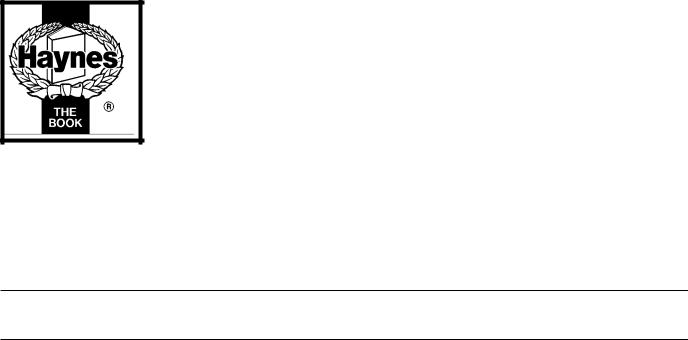
Jaguar XJ6
Service and Repair Manual
Mike Stubblefield
Models covered |
(3261-248-11AA1) |
Jaguar XJ6 models with 3.2 litre (3239 cc), 3.6 litre (3590 cc) & 4.0 litre (3980 cc) six-cylinder in-line dohc petrol engines and automatic transmission
Covers most features of Daimler 3.6 and 4.0 litre models
Does not cover 2.9 litre (2919 cc) sohc engine or manual transmission
Does not cover XJR models or revised Jaguar/Daimler model ranges introduced September 1994
© Haynes Publishing 1997 |
ABCDE |
|
FGHIJ |
|
KLMNO |
A book in the Haynes Service and Repair Manual Series |
PQRST |
1 2 3 |
All rights reserved. No part of this book may be reproduced or transmitted in any form or by any means, electronic or mechanical, including photocopying, recording or by any information storage or retrieval system, without permission in writing from the copyright holder.
ISBN 1 85960 261 4
British Library Cataloguing in Publication Data
A catalogue record for this book is available from the British Library.
Printed by J H Haynes & Co. Ltd, Sparkford, Nr Yeovil,
Somerset BA22 7JJ
Haynes Publishing
Sparkford, Nr Yeovil, Somerset BA22 7JJ, England
Haynes North America, Inc
861 Lawrence Drive, Newbury Park, California 91320, USA
Editions Haynes S.A.
147/149, rue Saint Honoré, 75001 PARIS, France
Haynes Publishing Nordiska AB
Fyrisborgsgatan 5, 754 50 Uppsala, Sverige
3261 Jaguar XJ6

Contents
LIVING WITH YOUR JAGUAR XJ6
Introduction |
Page 0•4 |
Notes for UK readers |
Page 0•4 |
|
|
Safety first! |
Page 0•5 |
|
|
Roadside repairs
Introduction |
Page 0•6 |
If your car won’t start |
Page 0•6 |
|
|
Jump starting |
Page 0•7 |
|
|
Wheel changing |
Page 0•8 |
|
|
Identifying leaks |
Page 0•9 |
|
|
Towing |
Page 0•9 |
|
|
Weekly checks
Introduction |
Page 0•10 |
Underbonnet check points |
Page 0•10 |
|
|
Engine oil level |
Page 0•11 |
|
|
Coolant level |
Page 0•11 |
|
|
Brake fluid level |
Page 0•12 |
|
|
Screen washer fluid level |
Page 0•12 |
|
|
Power steering fluid level |
Page 0•13 |
|
|
Wiper blades |
Page 0•13 |
|
|
Tyre condition and pressure |
Page 0•14 |
|
|
Battery |
Page 0•15 |
|
|
Bulbs and fuses |
Page 0•15 |
|
|
Lubricants, fluids and tyre pressures
Page 0•16
MAINTENANCE
Routine maintenance and servicing
Page 1•1
Servicing specifications |
Page 1•2 |
Maintenance schedule |
Page 1•3 |
|
|
Maintenance procedures |
Page 1•6 |
|
|
3261 Jaguar XJ6

|
Contents |
REPAIRS & OVERHAUL |
|
Engine and associated systems |
|
Engine in-car repair procedures |
Page 2A•1 |
|
|
Engine removal and overhaul procedures |
Page 2B•1 |
|
|
Cooling, heating and air conditioning systems |
Page 3•1 |
|
|
Fuel and exhaust systems |
Page 4•1 |
|
|
Engine electrical systems |
Page 5•1 |
|
|
Emissions and engine cone control systems |
Page 6•1 |
|
|
Transmission |
|
Automatic transmission |
Page 7•1 |
|
|
Drivetrain |
Page 8•1 |
|
|
Brakes and suspension |
|
Braking system |
Page 9•1 |
|
|
Suspension and steering systems |
Page 10•1 |
|
|
Body equipment |
|
Bodywork and fittings |
Page 11•1 |
|
|
Body electrical systems |
Page 12•1 |
|
|
Wiring diagrams
Page 12•16
REFERENCE
Dimensions and weights |
Page REF•1 |
Jacking and vehicle support |
Page REF•1 |
|
|
Radio/cassette unit anti-theft system - precaution |
Page REF•1 |
|
|
Conversion factors |
Page REF•2 |
|
|
Use of English |
Page REF•3 |
|
|
Buying spare parts and vehicle identification |
Page REF•4 |
|
|
General repair procedures |
Page REF•5 |
|
|
Tools and working facilities |
Page REF•6 |
|
|
MOT test checks |
Page REF•8 |
|
|
Fault finding |
Page REF•12 |
|
|
Glossary of technical terms |
Page REF•18 |
|
|
Index
Page REF•22
3261 Jaguar XJ6
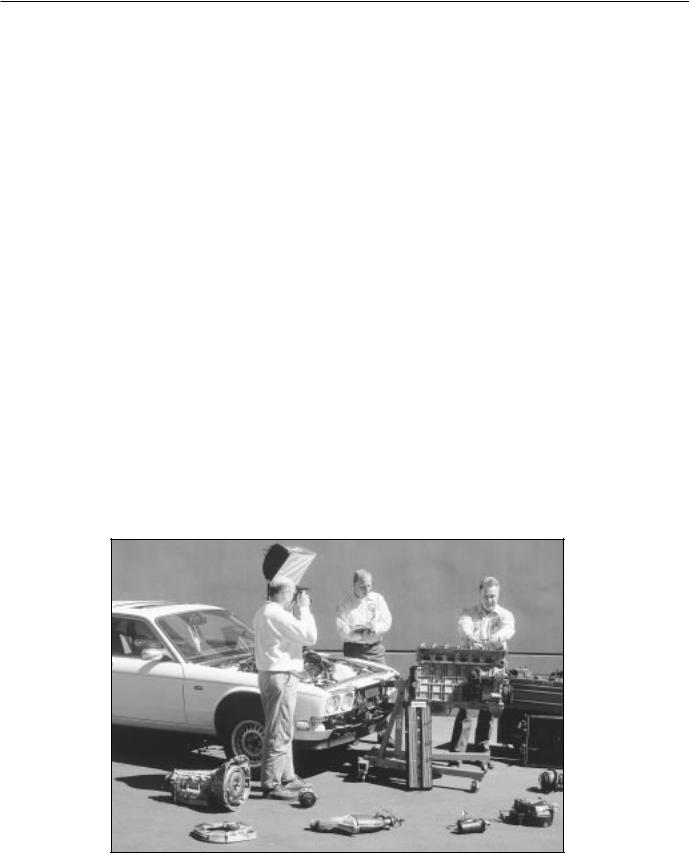
0•4 Introduction
These models are equipped with dual overhead cam in-line sixcylinder engines. The engines feature a computer-controlled ignition system and electronic fuel injection. Transmissions are a four-speed automatic equipped with a lock-up torque converter. The transmission is mounted to the back of the engine, and power is transmitted to the fully independent rear axle through a two-piece propshaft. The differential is bolted solidly to a frame crossmember and drives the wheels through driveshafts equipped with inner and outer U-joints.
The front suspension is fitted with upper and lower control arms, coil springs and shock absorbers. The rear suspension is an independent type suspension which also have coil spring/shock absorber assemblies and a lower control arm. The rear driveshaft acts as the upper control arm.
Power-assisted Anti-lock Brake Systems (ABS) with four-wheel disc brakes are standard equipment on all Jaguar XJ6 models covered in this manual. Power rack-and-pinion steering is also standard equipment.
Your Jaguar manual
The aim of this manual is to help you get the best value from your vehicle. It can do so in several ways. It can help you decide what work must be done (even should you choose to get it done by a garage). It will also provide information on routine maintenance and servicing, and give a logical course of action and diagnosis when random faults occur. However, it is hoped that you will use the manual by tackling the work yourself. On simpler jobs it may even be quicker than booking the car into a garage and going there twice, to leave and collect it. Perhaps most important, a lot of money can be saved by avoiding the costs a garage must charge to cover its labour and overheads.
The manual has drawings and descriptions to show the function of the various components so that their layout can be understood. Tasks are described and photographed in a clear step-by-step sequence.
Notes for UK readers
Because this manual was originally written in the US, its layout differs from our UK-originated manuals. The preliminary and reference sections have been re-written specifically for the UK market, and the maintenance schedule has been amended to suit UK vehicles. However, it will be noticed that some references to components
remain in the US style; the UK equivalent of US components and various other US words is given in the Section headed “Use of English”. It should be remembered that the project vehicle used in the main Chapters of this manual was a left-hand drive US model; therefore, the position of the steering wheel, steering column and pedals, etc. will be on the opposite side of the vehicle on UK models. References to “right” and “left” will need to be considered carefully to decide which applies to UK models (eg the headlight dipped beams should be adjusted to dip to the left of the headlight vertical line described in Chapter 12, instead of to the right on US models). In other instances, no reference is made to the location of a particular item, but that item may be located on the opposite side of the vehicle on UK models. Reference to the underbonnet photos at the start of Chapter 1 will give the reader the location of the engine compartment components on UK models.
All specifications in the main Chapters of the manual appear in Imperial form; the equivalent metric values can be calculated using the
“Conversion factors” page.
The only other major difference between UK and US models is in the level of emission control equipment fitted to the vehicle. To meet the strict emission standards present in the US, all vehicles for that market are fitted with various emission control systems (see Chapter 6), most of which are not fitted to the corresponding UK model, especially so on early models. Therefore, a lot of the information contained in Chapter 6 is not applicable to UK models.
Acknowledgements
Thanks are due to Jean Preis, Rich Wilson and Ray Marcuse of Silver Star Jaguar (Thousand Oaks, CA), Rick Calaci of Conejo Imports (Newbury Park, CA) and Jim Strohmeier and Jonathan Lund of British Motor Cars (Thousand Oaks, CA), for providing valuable technical information. Technical writers who contributed to this project include Jeff Kibler, Robert Maddox and Jay Storer.
We take great pride in the accuracy of information given in this manual, but vehicle manufacturers make alterations and design changes during the production run of a particular vehicle of which they do not inform us. No liability can be accepted by the authors or publishers for loss, damage or injury caused by any errors in, or omissions from, the information given.
Haynes mechanic, author and photographer with 1989 Jaguar XJ6
3261 Jaguar XJ6

Safety first! 0•5
Working on your car can be dangerous. This page shows just some of the potential risks and hazards, with the aim of creating a safety-conscious attitude.
General hazards
Scalding
•Don’t remove the radiator or expansion tank cap while the engine is hot.
•Engine oil, automatic transmission fluid or power steering fluid may also be dangerously hot if the engine has recently been running.
Burning
• Beware of burns from the exhaust system and from any part of the engine. Brake discs and drums can also be extremely hot immediately after use.
Crushing
•When working a raised vehicle, always supplement the jack with axle stands, or use drive-on ramps.
Never venture under a car
is only supported
•Take care if torque nuts Initial loosening be done with
Fire
•Fuel is highly explosive.
•Don’t let fuel
•Do not smoke (including pilot vehicle being creating sparks (electrically or by
•Fuel vapour is work on the fuel an inspection pit
•Another cause overload or short repairing or
•Keep a fire suitable for use
Electric shock
• Ignition HT voltage can be dangerous, especially to people with heart problems or a pacemaker. Don’t work on or near ignition system the engine running
the ignition switched on.
• Mains voltage is also dangerous. Make sure that any mains-operated equipment is correctly earthed. Mains power points should be protected by a residual current device (RCD) circuit breaker.
Fume or gas intoxication
•Exhaust fumes are poisonous; they contain carbon monoxide, which is rapidly fatal if inhaled Never run the engine in a
confined space such as a garage with the doors shut
•Fuel vapour is also poisonous, as are cleaning solvents
your pocket.
• Air conditioning poisonous gas if (including a cigarette) burns on contact.
Special hazards
Hydrofluoric acid
• This extremely corrosive acid is formed when certain types of synthetic rubber, found in some O-rings, oil seals, fuel hoses etc, are exposed to temperatures above 4000C. The
changes into a charred or sticky containing the acid. Once formed,
remains dangerous for years. If it the skin, it may be necessary to the limb concerned.
dealing with a vehicle which has
a fire, or with components salvaged a vehicle, wear protective gloves
them after use.
battery
• Batteries contain sulphuric acid, which attacks clothing, eyes and skin. Take care
topping-up or carrying the battery. hydrogen gas given off by the battery
explosive. Never cause a spark or naked light nearby. Be careful when and disconnecting battery
or jump leads.
can cause injury if they go off
. Take care when removing the wheel and/or facia. Special storage
instructions may apply.
Diesel injection equipment
• Diesel injection pumps supply fuel at very high pressure. Take care when working on the fuel injectors and fuel pipes.
Asbestos
• Asbestos dust can |
Warning: Never expose the hands, |
or swallowed. |
face or any other part of the body |
gaskets and in brake |
to injector spray; the fuel can |
When dealing with |
penetrate the skin with potentially fatal |
safest to assume |
results. |
Remember... |
A few tips |
|
DO |
DON’T |
|
• Do use eye protection when using power |
• Don’t attempt to lift a heavy component |
|
tools, and when working under the vehicle. |
which may be beyond your capability – get |
|
• Do wear gloves or use barrier cream to |
assistance. |
|
• Don’t rush to finish a job, or take |
||
protect your hands when necessary. |
||
• Do get someone to check periodically |
unverified short cuts. |
|
• Don’t use ill-fitting tools which may slip |
||
that all is well when working alone on the |
||
vehicle. |
and cause injury. |
|
• Do keep loose clothing and long hair well |
• Don’t leave tools or parts lying around |
|
out of the way of moving mechanical parts. |
where someone can trip over them. Mop |
|
• Do remove rings, wristwatch etc, before |
up oil and fuel spills at once. |
|
• Don’t allow children or pets to play in or |
||
working on the vehicle – especially the |
||
electrical system. |
near a vehicle being worked on. |
|
• Do ensure that any lifting or jacking |
|
|
equipment has a safe working load rating |
|
|
adequate for the job. |
|
|
|
|
3261 Jaguar XJ6
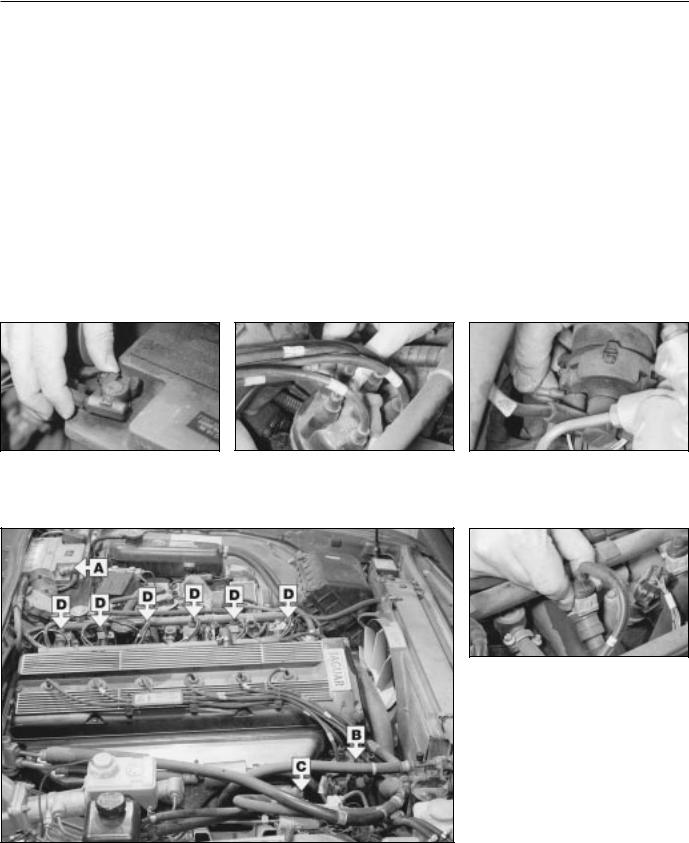
0•6 Roadside repairs
The following pages are intended to help in dealing with common roadside emergencies and breakdowns. You will find more detailed fault finding information at the back of the manual, and repair information in the main chapters.
If your car won’t start and the starter motor doesn’t turn
If your car won’t start even though the starter motor turns as normal
MIf it’s a model with automatic transmission, make sure the selector is in ‘P’ or ‘N’.
MOpen the bonnet and make sure that the battery terminals are clean and tight.
MSwitch on the headlights and try to start the engine. If the headlights go very dim when you’re trying to start, the battery is probably flat. Get out of trouble by jump starting (see next page) using a friend’s car.
MIs there fuel in the tank?
MIs there moisture on electrical components under the bonnet? Switch off the ignition, then wipe off any obvious dampness with a dry cloth. Spray a water-repellent aerosol product (WD-40 or equivalent) on ignition and fuel system electrical connectors like those shown in the photos.
Pay special attention to the ignition coil wiring connector and HT leads.
A battery connections. |
Check that the spark plug HT leads are |
B securely connected by pushing them onto |
|
|
the plugs and distributorery connections. |
C Check that the HT leads and wiring connectors are securely connected to the ignition coil.
D securely connected to the injectors and various fuel system sensors and switches.
Check that electrical connections are secure (with the ignition switched off) and spray them with a water dispersant spray like WD40 if you suspect a problem due to damp
3261 Jaguar XJ6
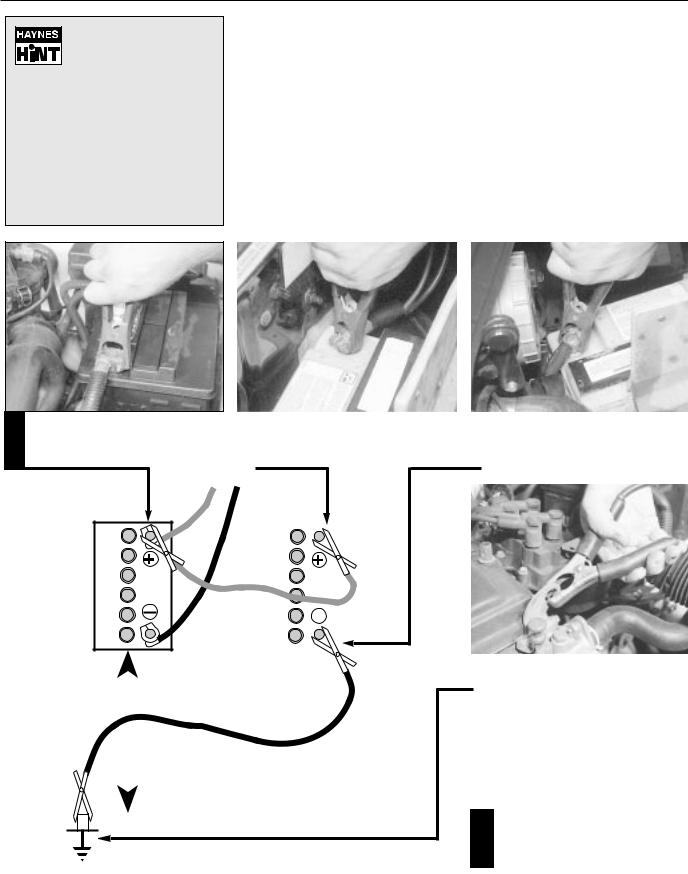
Roadside repairs 0•7
Jump starting will get you out of trouble, but you must
correct whatever made the battery go flat in the first
place. There are three possibilities:
1)The battery has been drained by repeated attempts to start, or by leaving the lights on.
2)The charging system is not working properly (alternator drivebelt slack or broken, alternator wiring fault or alternator itself faulty).
3)The battery itself is at fault (electrolyte low, or battery worn out).
1 to the positive (+) terminal of the flat battery
When jump-starting a car using a booster battery, observe the following precautions:
Before connecting the booster battery, make sure that the ignition is switched off.
Ensure that all electrical equipment (lights, heater, wipers, etc) is switched off.
Take note of any special precautions printed on the battery case.
Jump starting
Make sure that the booster battery is the same voltage as the discharged one in the vehicle.
If the battery is being jump-started from the battery in another vehicle, the two vehicles MUST NOT TOUCH each other.
Make sure that the transmission is in neutral (or PARK, in the case of automatic transmission).
|
|
|
|
|
|
|
|
|
2 |
|
Connect the other end of the red lead |
3 |
Connect one end of the black jump lead |
||||
|
|
to the positive (+) terminal of the |
|
to the negative (-) terminal of the |
||||
|
|
booster battery |
|
booster battery |
||||
|
|
|
|
|
|
|
|
|
|
|
|
|
|
|
|
|
|
|
|
|
|
|
|
|
|
|
|
|
|
|
|
|
|
|
|
|
|
|
|
|
|
|
|
|
|
|
|
|
|
|
|
|
|
|
|
|
4 |
jump lead to a bolt or bracket on the |
|||
|
|||||||
|
|
|
|
|
|
|
engine block, well away from the |
|
|
|
|
|
|
|
battery, on the vehicle to be started |
|
|
|
|
|
|
|
Make sure that the jump leads will not |
|
|
|
|
|
|
|
|
|
|
|
|
|
|
5 |
|
|
|
|
come into contact with the fan, |
||||
|
|
|
|
|
|
|
drivebelts or other moving parts of the |
|
|
|
|
|
|
|
engine |
|
|
|
|
|
|
|
Start the engine using the booster |
|
|
|
|
|
|
|
|
|
6 |
||||||
|
battery, then with the engine running at |
||||||
|
|||||||
idle speed, disconnect the jump leads in the reverse order of connection
3261 Jaguar XJ6
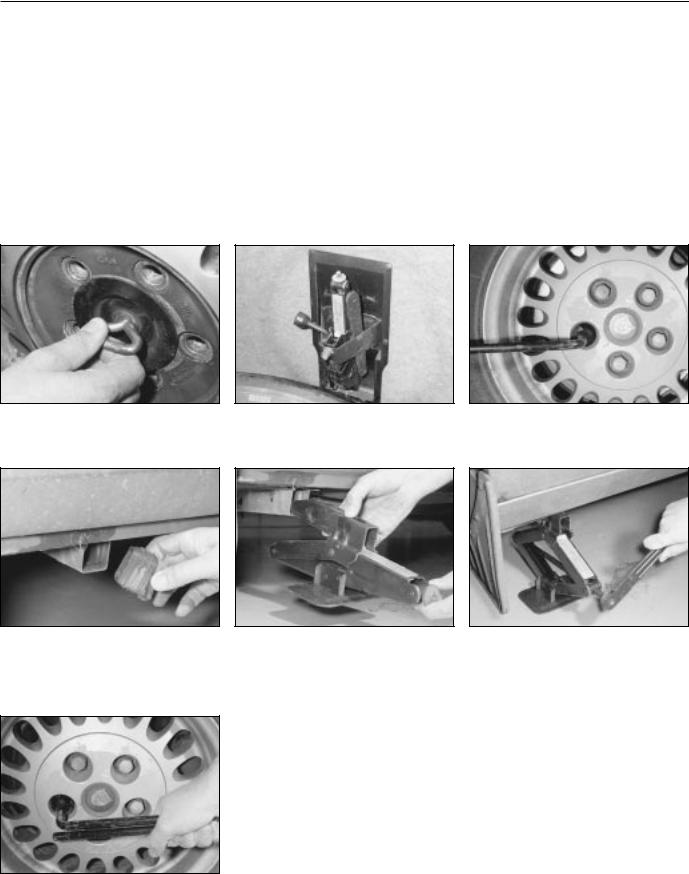
0•8 Roadside repairs
Wheel changing
Some of the details shown here will vary according to model. For instance, the location of the spare wheel and jack is not the same on all cars. However, the basic principles apply to all vehicles.
Warning: Do not change a wheel in a situation where you risk being hit by other traffic. On busy roads, try to stop in a lay-by or a gateway. Be wary of passing traffic while changing the wheel – it is easy to become distracted by the job in hand.
Preparation
MWhen a puncture occurs, stop as soon as it is safe to do so.
MPark on firm level ground, if possible, and well out of the way of other traffic.
MUse hazard warning lights if necessary.
MIf you have one, use a warning triangle to alert other drivers of your presence.
MApply the handbrake and engage first or reverse gear (or Park on models with automatic transmission.
MChock the wheel diagonally opposite the one being removed – a couple of large stones will do for this.
MIf the ground is soft, use a flat piece of wood to spread the load under the jack.
Changing the wheel
1 The spare wheel and tools are stored in the boot. Remove the carpet cover then unscrew the retainer and lift out the spare
wheel from the boot.
4 Remove the plastic cover from the end of the vehicle jack lifting point tube, nearest to the wheel that is being changed.
2 Remove the jack and wheelbrace its holder which is located behind the spare wheel.
5 Slide the lifting bracket of the jack fully into the lifting point tube. Make sure the jack is located on firm ground.
3 With the vehicle on the ground, remove the trim cap (where fitted) and slacken each wheel nut by half a turn.
6 Raise the jack until the wheel is raised clear of the ground. Unscrew the wheel nuts and remove the wheel. Fit the spare wheel and screw on the nuts. Lightly tighten the nuts then lower the vehicle to the ground.
7 Securely tighten the wheel nuts in a diagonal sequence then (where necessary) refit the wheel trim cap. Stow the tolls and punctured wheel and back in the luggage compartment and secure them in position. Note that the wheel nuts should be slackened and retightened to the specified torque at the
earliest possible opportunity.
Finally...
MRemove the wheel chocks.
MCheck the tyre pressure on the wheel just fitted. If it is low, or if you don’t have a pressure gauge with you, drive slowly to the nearest garage and inflate the tyre to the right pressure.
MHave the damaged tyre or wheel repaired as soon as possible.
3261 Jaguar XJ6
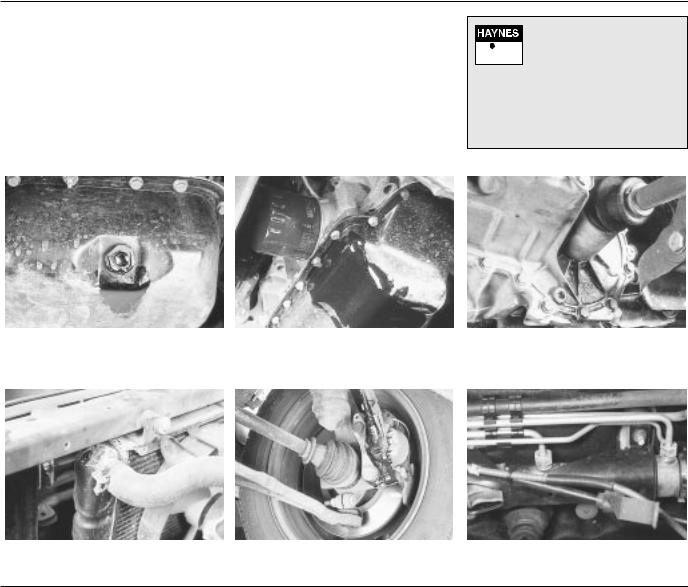
Roadside repairs 0•9
Puddles on the garage floor or drive, or obvious wetness under the bonnet or underneath the car, suggest a leak that needs investigating. It can sometimes be difficult to decide where the leak is coming from, especially if the engine bay is very dirty already. Leaking oil or fluid can also be blown rearwards by the passage of air under the car, giving a false impression of where the problem lies.
Warning: Most automotive oils and fluids are poisonous. Wash them off skin, and change out of contaminated clothing, without delay.
The smell of a fluid leaking from the car may provide a


 clue to what’s leaking. Some fluids are distinctively
clue to what’s leaking. Some fluids are distinctively
coloured. It may help to clean the car and to park it over some clean paper as an aid to locating the source of the leak. Remember that some leaks may only occur while the engine is running.
Sump oil |
|
Oil from filter |
|
Gearbox oil |
|
|
|
|
|
...or from the base of the oil filter.
Gearbox oil can leak from the seals at the inboard ends of the driveshafts.
Antifreeze |
|
Brake fluid |
|
Power steering fluid |
|
|
|
|
|
Leaking antifreeze often leaves a crystalline deposit like this.
A leak occurring at a wheel is almost certainly brake fluid.
Power steering fluid may leak from the pipe connectors on the steering rack.
When all else fails, you may find yourself having to get a tow home – or of course you may be helping somebody else. Long-distance recovery should only be done by a garage or breakdown service. For shorter distances, DIY towing using another car is easy enough, but observe the following points:
MUse a proper tow-rope – they are not expensive. The vehicle being towed must display an ‘ON TOW’ sign in its rear window.
MAlways turn the ignition key to the ‘on’ position when the vehicle is being towed, so that the steering lock is released, and that the direction indicator and brake lights will work.
MOnly attach the tow-rope to the towing eyes provided. On some models with energyabsorbing bumpers there are no front towing eyes; on these vehicles the tow-rope should
be attached around the rear arm of the lower control arm so that the rope passes on the inside of the coil spring.
MBefore being towed, release the handbrake and select neutral on the transmission.
MNote that greater-than-usual pedal pressure will be required to operate the brakes, since the vacuum servo unit is only operational with the engine running.
MOn models with power steering, greater- than-usual steering effort will also be required.
MThe driver of the car being towed must keep the tow-rope taut at all times to avoid snatching.
MMake sure that both drivers know the route before setting off.
MOnly drive at moderate speeds and keep the distance towed to a minimum. Drive
Towing
smoothly and allow plenty of time for slowing down at junctions.
M On models with automatic transmission, special precautions apply. If in doubt, do not tow, or transmission damage may result.
Caution: On models with automatic transmission, if the vehicle is to be towed with its rear wheels on the ground, and extra 1.7 litres of fluid should be added to the transmission, prior to towing (this extra fluid must be drained before driving the vehicle). Even with the extra fluid added to the transmission, do not tow the vehicle at speeds in excess of 30 mph (50 kmh) or for a distance of greater than 15 miles (25 km). If towing speed/distance are to exceed these limits, then the vehicle must be towed with its rear wheels off the ground.
3261 Jaguar XJ6
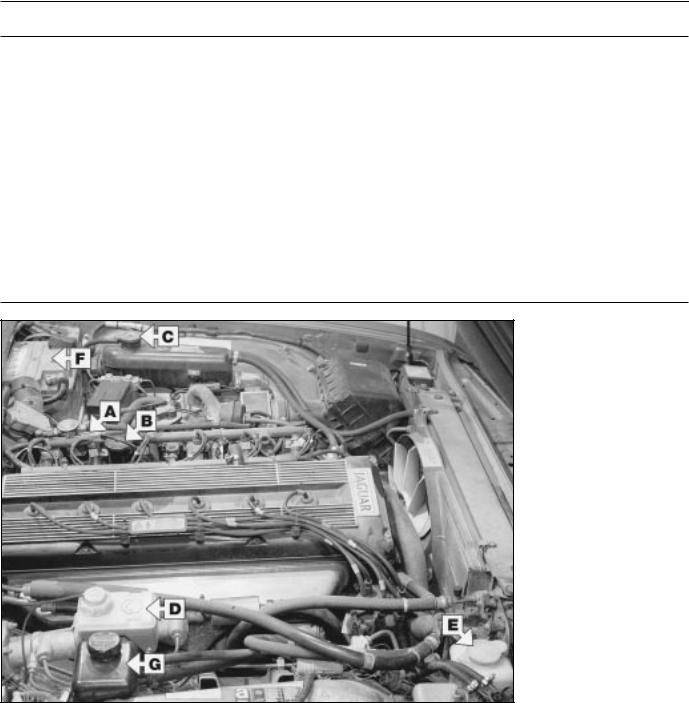
0•10 Weekly checks
Introduction
There are some very simple checks which need only take a few minutes to carry out, but which could save you a lot of inconvenience and expense.
M Keeping an eye on tyre condition and pressures, will not only help to stop them wearing out prematurely, but could also save your life.
M If your car develops a brake fluid leak, the first time you might know about it is when your brakes don't work properly. Checking the level regularly will give advance warning of this kind of problem.
These "Weekly checks" require no great skill or special tools, and the small amount of time they take to perform could prove to be very well spent, for example;
M Many breakdowns are caused by electrical problems. Battery-related faults are particularly common, and a quick check on a regular basis will often prevent the majority of these.
M If the oil or coolant levels run low, the cost of repairing any engine damage will be far greater than fixing the leak, for example.
Underbonnet check points
ß 3.6 litre engine
(others similar)
Viewed from right-hand side
A Engine oil level dipstick
B Engine oil filler cap
C Coolant expansion tank
D Brake fluid reservoir
E Screen washer fluid reservoir
F Battery
G Power steering fluid reservoir
3261 Jaguar XJ6
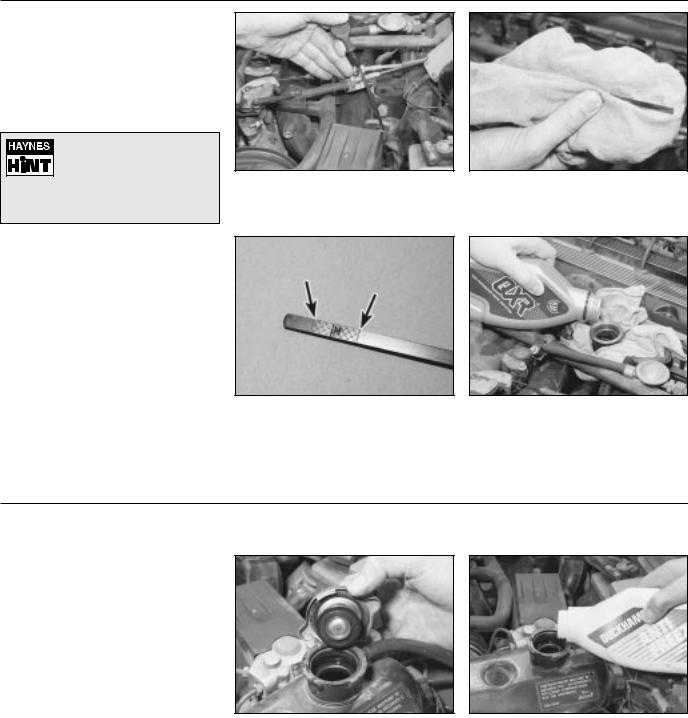
Weekly checks 0•11
Engine oil level
Before you start
Make sure that your car is on level ground.
Check the oil level before the car is driven, or at least 5 minutes after the engine has been switched off.
If the oil level is checked |
immediately after driving the |
vehicle, some of the oil will |
remain in the upper engine |
components, resulting in an inaccurate |
reading on the dipstick! |
1 The dipstick is located at the rear of the engine on the left-hand side (see “Underbonnet check points” on page 0•10 for exact location). Withdraw the dipstick.
2 Using a clean rag or paper towel remove all oil from the dipstick. Insert the clean dipstick into the tube as far as it will go, then withdraw it again.
The correct oil
Modern engines place great demands on their oil. It is very important that the correct oil for your car is used (See “Lubricants, fluids and tyre pressures”).
Car care
●If you have to add oil frequently, you should check whether you have any oil leaks. Place some clean paper under the car overnight, and check for stains in the morning. If there are no leaks, the engine may be burning oil
(see “Fault finding”).
●Always maintain the level between the upper and lower dipstick marks (see photo 3). If the level is too low severe engine damage may occur. Oil seal failure may result if the engine is overfilled by adding too much oil.
3 Note the oil level on the end of the dipstick which should be between the upper and lower marks. The “M” mark is for use when checking the oil level after the
vehicle has been standing overnight; in this case the oil level should be between the “M” and upper level markings.
4 Oil is added through the filler cap. Unscrew the cap and top-up the level; a funnel may help to reduce spillage. Add the oil slowly, checking the level on the dipstick
often. Don’t overfill (see “Car care” left).
Coolant level
Warning: DO NOT attempt to remove the expansion tank pressure cap when the engine is hot, as there is a very great risk of scalding. Do not leave open containers of coolant about, as it is poisonous.
Car care
●Adding coolant should not be necessary on a regular basis. If frequent topping-up is required, it is likely there is a leak. Check the radiator, all hoses and joint faces for signs of staining or wetness, and rectify as necessary.
●It is important that antifreeze is used in the cooling system all year round, not just during the winter months. Don’t top-up with water alone, as the antifreeze will become too diluted.
1 The coolant level should be checked only with the engine cold. The level is checked in the expansion tank on the left-hand
side of the engine compartment. Remove the expansion tank pressure cap and check that the coolant level is upto the base of filler neck.
2 If topping up is necessary, add a mixture of water and antifreeze to the expansion tank until the coolant level is upto the base of the filler neck. Once the level is
correct, securely refit the pressure cap.
3261 Jaguar XJ6
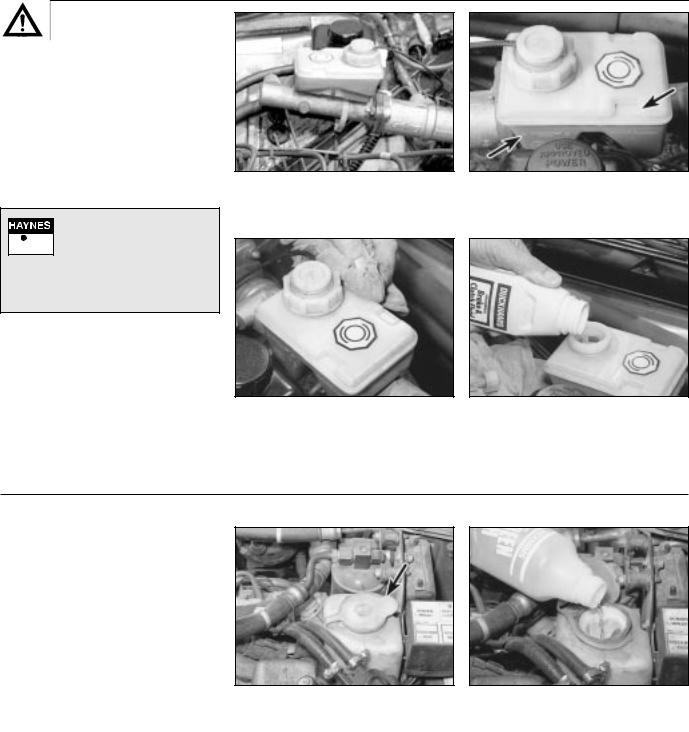
0•12 Weekly checks
Brake fluid level
Warning:
●Brake fluid can harm your eyes and will damage painted surfaces, so use extreme caution when handling and pouring it.
●Do not use fluid that has been standing open for some time, as it absorbs moisture from the air, which can cause a dangerous loss of braking effectiveness.
•Make sure that your car is on level ground.


 • The fluid level in the reservoir will drop slightly as the brake pads wear down, but the fluid
• The fluid level in the reservoir will drop slightly as the brake pads wear down, but the fluid
level must never be allowed to drop below the “MIN” mark.
1 The brake fluid reservoir is located on the right-hand rear corner of the engine compartment, on top of the master cylinder.
2 The upper (MAX) and lower (MIN) fluid level markings are on the side of the brake fluid reservoir. The fluid level must always be kept between these two marks.
Safety first!
●If the reservoir requires repeated toppingup this is an indication of a fluid leak somewhere in the system, which should be investigated immediately.
●If a leak is suspected, the car should not be driven until the braking system has been checked. Never take any risks where brakes are concerned.
3 If topping up is necessary, first wipe clean the area around the filler cap with a clean cloth then unscrew the cap and position it clear of the reservoir.
4 Carefully add fluid, avoiding spilling it on the surrounding paintwork. Use only the specified hydraulic fluid. After filling the correct level, refit the cap and tighten it
securely. Wipe off any spilt fluid.
Screen washer fluid level
Screenwash additives not only keep the winscreen clean during foul weather, they also prevent the washer system freezing in cold weather - which is when you are likely to need it most. Don’t top up using plain water as the screenwash will become too diluted, and will freeze during cold weather. On no account use coolant antifreeze in the washer system - this could discolour or damage paintwork.
1 The screen washer fluid reservoir is located in the front, right-hand corner of the engine compartment. The level is visible through the reservoir body.
2 If topping up is necessary, add water and a screenwash additive in the quantities recommended on the bottle.
3261 Jaguar XJ6
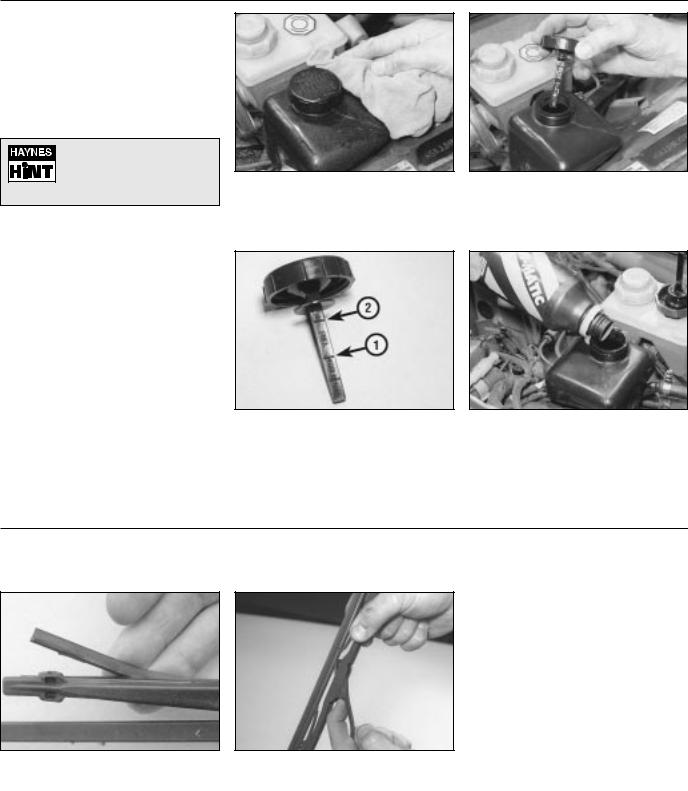
Weekly checks 0•13
Power steering fluid level
Before you start:
Park the vehicle on level ground.
Set the steering wheel straight-ahead.
The engine should be turned off.
For the check to be accurate, the steering must not be turned once the engine has been stopped.
Safety first!
The need for frequent topping-up indicates a leak, which should be investigated immediately.
Warning:
This check applies only to vehicles fitted with a separate power steering system. For vehicles fitted with power steering where the fluid
reservoir is part of the power hydraulic system, this weekly check is not applicable.
It is essential to use the correct power steering fluid, this being dependent on the year of manufacture and type of system fitted. A label attached to the fluid reservoir will indicate the specification of fluid. However, if necessary refer to the driver’s handbook supplied with the vehicle or to your local Jaguar dealer.
1 Wipe clean the area around the reservoir cap then remove the cap noting that it unscrews in a clockwise direction (see arrow on cap).
3 Note the fluid level on the end of the dipstick. If the fluid is cold (vehicle not having been used) the fluid level should be upto the COLD level marking (1). If the
vehicle has been driven and the fluid is hot then the fluid level should be upto the upper (HOT) level marking (2).
2 Wipe clean the cap dipstick then insert it fully into the reservoir and withdraw it.
4 If necessary, top-up the reservoir with the specified type of fluid (note that the type of fluid differs according to model - see
“Lubricants, fluids and tyre pressures” on page 0•16). Once the level is correct, securely refit the reservoir cap. Do not overfill the reservoir.
Wiper blades
1 Check the condition of the wiper blades: if they are cracked or show signs of deterioration, or if the glass swept area is smeared, renew them. For maximum clarity of vision, wiper blades should be renewed
annually.
2 To remove a wiper blade, pull the arm fully away from the screen until it locks. Swivel the blade then depress the locking clip at the base of the mounting block and
slide the blade off the arm.
3261 Jaguar XJ6

0•14 Weekly checks
Tyre condition and pressure
It is very important that tyres are in good condition, and at the correct pressure - having a tyre failure at any speed is highly dangerous. Tyre wear is influenced by driving style - harsh braking and acceleration, or fast cornering, will all produce more rapid tyre wear. As a general rule, the front tyres wear out faster than the rears. Interchanging the tyres from front to rear ("rotating" the tyres) may result in more even wear. However, if this is completely effective, you may have the expense of replacing all four tyres at once!
Remove any nails or stones embedded in the tread before they penetrate the tyre to cause deflation. If removal of a nail does reveal that
the tyre has been punctured, refit the nail so that its point of penetration is marked. Then immediately change the wheel, and have the tyre repaired by a tyre dealer.
Regularly check the tyres for damage in the form of cuts or bulges, especially in the sidewalls. Periodically remove the wheels, and clean any dirt or mud from the inside and outside surfaces. Examine the wheel rims for signs of rusting, corrosion or other damage. Light alloy wheels are easily damaged by "kerbing" whilst parking; steel wheels may also become dented or buckled. A new wheel is very often the only way to overcome severe damage.
New tyres should be balanced when they are fitted, but it may become necessary to rebalance them as they wear, or if the balance weights fitted to the wheel rim should fall off. Unbalanced tyres will wear more quickly, as will the steering and suspension components. Wheel imbalance is normally signified by vibration, particularly at a certain speed (typically around 50 mph). If this vibration is felt only through the steering, then it is likely that just the front wheels need balancing. If, however, the vibration is felt through the whole car, the rear wheels could be out of balance. Wheel balancing should be carried out by a tyre dealer or garage.
1 Tread Depth - visual check
The original tyres have tread wear safety bands (B), which will appear when the tread depth reaches approximately 1.6 mm. The band positions are indicated by a triangular mark on the tyre sidewall (A).
2 Tread Depth - manual check
Alternatively, tread wear can be monitored with a simple, inexpensive device known as a tread depth indicator gauge.
3 Tyre Pressure Check
Check the tyre pressures regularly with the tyres cold. Do not adjust the tyre pressures immediately after the vehicle has been used, or an inaccurate setting will result.
Tyre tread wear patterns
Shoulder Wear
Underinflation (wear on both sides)
Under-inflation will cause overheating of the tyre, because the tyre will flex too much, and the tread will not sit correctly on the road surface. This will cause a loss of grip and excessive wear, not to mention the danger of sudden tyre failure due to heat build-up.
Check and adjust pressures
Incorrect wheel camber (wear on one side)
Repair or renew suspension parts
Hard cornering
Reduce speed!
Centre Wear
Overinflation
Over-inflation will cause rapid wear of the centre part of the tyre tread, coupled with reduced grip, harsher ride, and the danger of shock damage occurring in the tyre casing.
Check and adjust pressures
If you sometimes have to inflate your car’s tyres to the higher pressures specified for maximum load or sustained high speed, don’t forget to reduce the pressures to normal afterwards.
Uneven Wear
Front tyres may wear unevenly as a result of wheel misalignment. Most tyre dealers and garages can check and adjust the wheel alignment (or "tracking") for a modest charge.
Incorrect camber or castor
Repair or renew suspension parts
Malfunctioning suspension
Repair or renew suspension parts
Unbalanced wheel
Balance tyres
Incorrect toe setting
Adjust front wheel alignment
Note: The feathered edge of the tread which typifies toe wear is best checked by feel.
3261 Jaguar XJ6
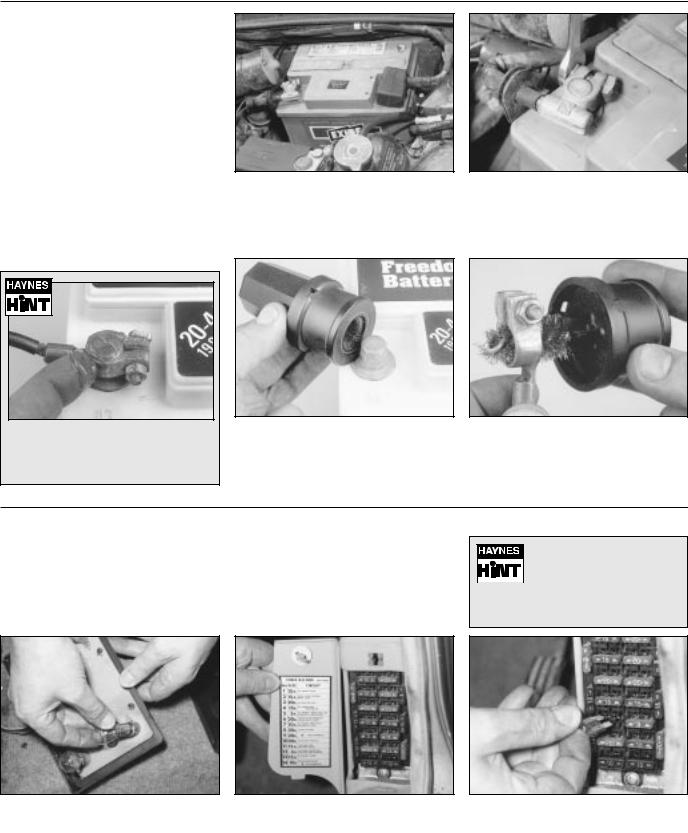
Weekly checks 0•15
Battery
Caution: Before carrying out any work on the vehicle battery, read the precautions given in "Safety first" at the start of this manual.
Make sure that the battery tray is in good condition, and that the clamp is tight. Corrosion on the tray, retaining clamp and the battery itself can be removed with a solution of water and baking soda. Thoroughly rinse all cleaned areas with water. Any metal parts damaged by corrosion should be covered with a zinc-based primer, then painted.
Periodically (approximately every three months), check the charge condition of the battery as described in Chapter 5.
If the battery is flat, and you need to jump start your vehicle, see Roadside Repairs.
Battery corrosion can be kept to a minimum by applying a layer of petroleum jelly to the clamps and terminals after they are reconnected.
1 The battery is located in the left-hand, rear corner of the engine compartment. Check the battery terminals for signs of corrosion and examine the battery leads
closely for signs of damage.
If corrosion (white, fluffy deposits) is 3 evident, remove the cables from the battery terminals, clean them with a small wire brush, then refit them. Automotive stores
sell a tool for cleaning the battery post . . .
2 Check the battery lead clamps for tightness to ensure good electrical connections.
4 . . . as well as the battery cable clamps
Bulbs and fuses
Check all external lights and the horn. Refer to the appropriate Sections of Chapter 12 for details if any of the circuits are found to be inoperative.
Visually check all accessible wiring connectors, harnesses and retaining clips for security, and for signs of chafing or damage.
If you need to check |
your |
brake lights and indicators |
|
unaided, back up to a wall or |
|
garage door and operate the |
|
lights. The reflected light should show if |
|
they are working properly. |
|
1 If a single indicator light, stop light or headlight has failed, it is likely that a bulb has blown and will need to be replaced.
Refer to Chapter 12 for details. If both stop lights have failed, it is possible that the switch has failed (see Chapter 9).
If more than one indicator light or tail light 2 has failed it is likely that either a fuse has blown or that there is a fault in the circuit. The fuseboxes are located behind the left and right side kick panels and in the centre
console glove box (see Chapter 12).
3 To replace a blown fuse, simply pull it out and fit a new fuse of the correct rating (see Chapter 12). If the fuse blows again, it is important that you find out why - a
complete checking procedure is given in Chapter 12.
3261 Jaguar XJ6
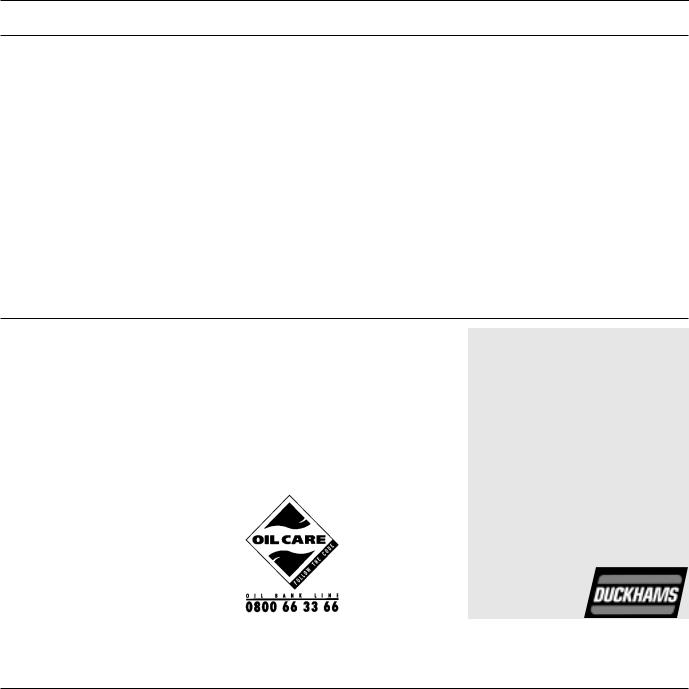
0•16 Lubricants, fluids and tyre pressures
Lubricants and fluids
Engine . . . . . . . . . . . . . . . . . . . . . . . . . . |
Multigrade engine oil to API SG or higher (Duckhams QS, QXR, Hypergrade Plus, |
|
Hypergrade, or 10W-40 Motor Oil) |
Cooling system . . . . . . . . . . . . . . . . . . . |
Ethylene glycol based (phosphate free) antifreeze |
|
(Duckhams Antifreeze and Summer Coolant) |
Automatic transmission . . . . . . . . . . . . |
Dexron type II automatic transmission fluid (ATF) (Duckhams Uni-Matic) |
Differential: |
|
Standard differential . . . . . . . . . . . . . . |
SAE EP90 to API GL5 (Duckhams 80W-90S Gear Oil) |
Powr-lok differential . . . . . . . . . . . . . . . |
SAE 90 to API GL5 (Duckhams Hypoid 90 DL) |
Braking system . . . . . . . . . . . . . . . . . . . |
Hydraulic fluid to DOT 4 (Duckhams Universal Brake and Clutch Fluid) |
Power steering (with separate reservoir) . |
dependent on year of manufacture and system fitted - refer to your Jaguar dealer |
Power hydraulic system . . . . . . . . . . . . . |
Castrol or Jaguar hydraulic system mineral oil (HSMO) Refer to your Jaguar dealer |
Choosing your engine oil
Oils perform vital tasks in all engines. The higher the engine’s performance, the greater the demand on lubricants to minimise wear as well as optimise power and economy. Duckhams tailors lubricants to the highest technical standards, meeting and exceeding the demands of all modern engines.
HOW ENGINE OIL WORKS
• Beating friction
Without oil, the surfaces inside your engine which rub together will heat, fuse and quickly cause engine seizure. Oil, and its special additives, forms a molecular barrier between moving parts, to stop wear and minimise heat build-up.
• Cooling hot spots
Oil cools parts that the engine’s water-based coolant cannot reach, bathing the combustion chamber and pistons, where temperatures may exceed 1000°C. The oil assists in
transferring the heat to the engine cooling system. Heat in the oil is also lost by air flow over the sump, and via any auxiliary oil cooler.
• Cleaning the inner engine
Oil washes away combustion by-products (mainly carbon) on pistons and cylinders, transporting them to the oil filter, and holding the smallest particles in suspension until they are flushed out by an oil change. Duckhams oils undergo extensive tests in the laboratory, and on the road.
Note: It is antisocial and illegal to dump oil down the drain. To find the location of your local oil
bank, call this number free.
Engine oil types
Mineral oils are the “traditional” oils, generally suited to older engines and cars not used in harsh conditions. Duckhams Hypergrade Plus and Hypergrade are well suited for use in most popular family cars.
Diesel oils such as Duckhams Diesel are specially formulated for Diesel engines, including turbocharged models and 4x4s.
Synthetic oils are the state-of-the-art in lubricants, offering ultimate protection, but at a fairly high price. One such is Duckhams QS, for use in ultra-high performance engines.
Semi-synthetic oils offer high performance engine protection, but at less cost than full synthetic oils. Duckhams QXR is an ideal choice for hot hatches and hard-driven cars.
Tyre pressures
Note: Tyre pressures must always be checked with the tyres cold to ensure accuracy.
Front . . . . . . . . . . . . . . . . . . . . . . . . . . . . . . . . . . . . . . . . . . . |
34 psi (2.3 bar) |
Rear . . . . . . . . . . . . . . . . . . . . . . . . . . . . . . . . . . . . . . . . . . . |
34 psi (2.3 bar) |
Note: Jaguar state that the tyre pressures maybe reduced by up to 8 psi (0.6 bar) on the front tyres and 6 psi (0.4 bar) on the rear tyres to increase the ride comfort. This is only allowable if the vehicle is not to be driven at speeds in excess of 100 mph (160 kmh); if speeds are to exceed this, the tyres must be run at the specified pressures.
3261 Jaguar XJ6
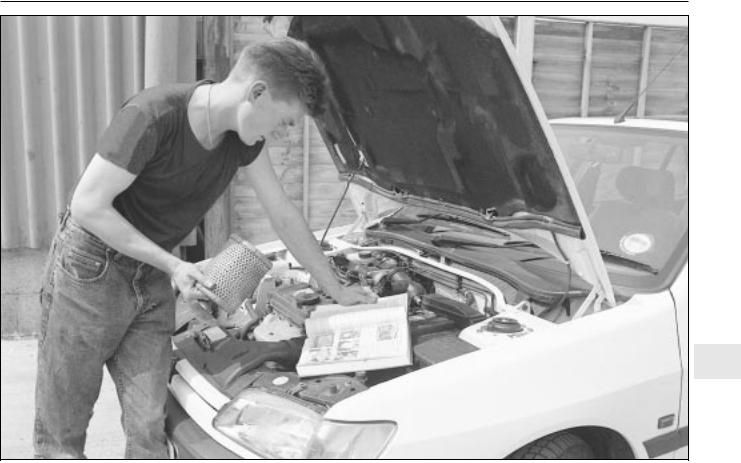
1•1
Chapter 1
Routine maintenance and servicing
1
Contents
Air cleaner element renewal . . . . . . . . . . . . . . . . . . . . . . . . . . . . . . . . |
17 |
Automatic transmission fluid and filter renewal . . . . . . . . . . . . . . . . . |
26 |
Automatic transmission fluid level check . . . . . . . . . . . . . . . . . . . . . |
8 |
Battery check and general information . . . . . . . . . . . . . . . . . . . . . . . |
6 |
Brake fluid renewal . . . . . . . . . . . . . . . . . . . . . . . . . . . . . . . . . . . . . . |
28 |
Braking system - general check and adjustment . . . . . . . . . . . . . . . |
11 |
Coolant renewal . . . . . . . . . . . . . . . . . . . . . . . . . . . . . . . . . . . . . . . . . |
30 |
Crankcase ventilation system check . . . . . . . . . . . . . . . . . . . . . . . . . |
20 |
Differential oil level check . . . . . . . . . . . . . . . . . . . . . . . . . . . . . . . . . |
9 |
Differential oil renewal . . . . . . . . . . . . . . . . . . . . . . . . . . . . . . . . . . . . |
27 |
Drivebelt check and renewal . . . . . . . . . . . . . . . . . . . . . . . . . . . . . . . |
21 |
Engine oil and filter renewal . . . . . . . . . . . . . . . . . . . . . . . . . . . . . . . . |
3 |
Exhaust system check . . . . . . . . . . . . . . . . . . . . . . . . . . . . . . . . . . . . |
10 |
Front wheel alignment check . . . . . . . . . . . . . . . . . . . . . . . . . . . . . . . |
24 |
Front wheel bearing check and adjustment . . . . . . . . . . . . . . . . . . . |
22 |
Fuel filter renewal . . . . . . . . . . . . . . . . . . . . . . . . . . . . . . . . . . . . . . . . |
18 |
General information . . . . . . . . . . . . . . . . . . . . . . . . . . . . . . . . . . . . . . |
1 |
General lubrication . . . . . . . . . . . . . . . . . . . . . . . . . . . . . . . . . . . . . . . |
14 |
Handbrake shoes check . . . . . . . . . . . . . . . . . . . . . . . . . . . . . . . . . . |
29 |
Headlight beam check . . . . . . . . . . . . . . . . . . . . . . . . . . . . . . . . . . . . |
25 |
Hose and fluid leak check . . . . . . . . . . . . . . . . . . . . . . . . . . . . . . . . . |
7 |
Ignition system check . . . . . . . . . . . . . . . . . . . . . . . . . . . . . . . . . . . . |
19 |
Intensive maintenance . . . . . . . . . . . . . . . . . . . . . . . . . . . . . . . . . . . . |
2 |
Power hydraulic system fluid level check . . . . . . . . . . . . . . . . . . . . . |
5 |
Propshaft check . . . . . . . . . . . . . . . . . . . . . . . . . . . . . . . . . . . . . . . . . |
23 |
Road test . . . . . . . . . . . . . . . . . . . . . . . . . . . . . . . . . . . . . . . . . . . . . . |
15 |
Seat belt check . . . . . . . . . . . . . . . . . . . . . . . . . . . . . . . . . . . . . . . . . |
13 |
Spark plug check . . . . . . . . . . . . . . . . . . . . . . . . . . . . . . . . . . . . . . . . |
4 |
Spark plug renewal . . . . . . . . . . . . . . . . . . . . . . . . . . . . . . . . . . . . . . |
16 |
Steering and suspension check . . . . . . . . . . . . . . . . . . . . . . . . . . . . |
12 |
Degrees of difficulty
|
|
|
|
|
|
|
|
|
|
|
|
|
|
|
Easy, suitable for |
1 |
|
Fairly easy, suitable |
2 |
|
Fairly difficult, |
3 |
|
Difficult, suitable for |
4 |
|
Very difficult, |
5 |
|
|
|
|
|
|
||||||||||
novice with little |
|
for beginner with |
|
suitable for competent |
|
experienced DIY |
|
suitable for expert DIY |
|
|||||
experience |
|
some experience |
|
DIY mechanic |
|
mechanic |
|
or professional |
|
|||||
|
|
|
|
|
|
|
|
|
|
|
|
|
|
|
|
|
|
|
|
|
|
|
|
|
|
|
|
|
|
3261 Jaguar XJ6

1•2 Servicing specifications
Lubricants and fluids
Refer to “Weekly checks”
Capacities
Engine oil |
|
Including oil filter . . . . . . . . . . . . . . . . . . . . . . . . . . . . . . . . . . . . . . . . . . . |
8.0 litres |
Cooling system |
|
All models (approximate): |
|
From dry . . . . . . . . . . . . . . . . . . . . . . . . . . . . . . . . . . . . . . . . . . . . . . . |
12.8 litres |
Drain and refill . . . . . . . . . . . . . . . . . . . . . . . . . . . . . . . . . . . . . . . . . . . |
9.2 litres |
Transmission |
|
Automatic transmission (approximate): |
|
From dry: |
|
3.2 litre model . . . . . . . . . . . . . . . . . . . . . . . . . . . . . . . . . . . . . . . . . |
7.4 litres |
3.6 and 4.0 litre models . . . . . . . . . . . . . . . . . . . . . . . . . . . . . . . . . |
8.0 litres |
Drain and refill . . . . . . . . . . . . . . . . . . . . . . . . . . . . . . . . . . . . . . . . . . . |
3.0 litres |
Differential |
|
All models (approximate) . . . . . . . . . . . . . . . . . . . . . . . . . . . . . . . . . . . . |
2.1 litres |
Cooling system
Antifreeze mixture: |
|
50% antifreeze . . . . . . . . . . . . . . . . . . . . . . . . . . . . . . . . . . . . . . . . . . |
Protection down to -37°C (5°F) |
55% antifreeze . . . . . . . . . . . . . . . . . . . . . . . . . . . . . . . . . . . . . . . . . . |
Protection down to -45°C (-22°F) |
Note: Refer to antifreeze manufacturer for latest recommendations. |
|
Ignition system
Spark plugs: |
|
|
Type: |
|
|
3.2 litre model . . . . . . . . . . . . . . . . . . . . . . . . . . . . . . . . . . . . . . . . . |
RC12YCC |
|
3.6 and 4.0 litre models . . . . . . . . . . . . . . . . . . . . . . . . . . . . . . . . . |
RC9YCC |
|
Electrode gap . . . . . . . . . . . . . . . . . . . . . . . . . . . . . . . . . . . . . . . . . . . |
0.9 mm |
|
*The spark plug gap quoted is that recommended by Champion |
|
|
for their specified plug listed above. If spark plugs of any other type |
|
|
are to be fitted, refer to their manufacturer’s recommendations. |
|
|
Engine firing order . . . . . . . . . . . . . . . . . . . . . . . . . . . . . . . . . . . . . . . . . |
1-5-3-6-2-4 |
|
Distributor rotation . . . . . . . . . . . . . . . . . . . . . . . . . . . . . . . . . . . . . . . . . |
Clockwise |
|
Ignition timing . . . . . . . . . . . . . . . . . . . . . . . . . . . . . . . . . . . . . . . . . . . . . |
See Chapter 5 |
|
Brakes |
|
Cylinder location and distributor rotation |
Disc brake pad friction material minimum thickness: |
|
|
Front . . . . . . . . . . . . . . . . . . . . . . . . . . . . . . . . . . . . . . . . . . . . . . . . . |
4.0 mm |
|
Rear . . . . . . . . . . . . . . . . . . . . . . . . . . . . . . . . . . . . . . . . . . . . . . . . . |
3.0 mm |
|
Handbrake shoe friction material minimum thickness . . . . . . . . . . . . . . |
1.5 mm |
|
Handbrake adjustment . . . . . . . . . . . . . . . . . . . . . . . . . . . . . . . . . . . . . . |
3 to 5 clicks |
|
Torque wrench settings |
Nm |
lbf ft |
Automatic transmission sump pan bolts . . . . . . . . . . . . . . . . . . . . . . . . |
8 |
6 |
Automatic transmission dipstick tube nut . . . . . . . . . . . . . . . . . . . . . . . |
20 |
15 |
Spark plugs . . . . . . . . . . . . . . . . . . . . . . . . . . . . . . . . . . . . . . . . . . . . . . . |
23 to 28 |
17 to 21 |
Wheel nuts . . . . . . . . . . . . . . . . . . . . . . . . . . . . . . . . . . . . . . . . . . . . . . . |
102 |
75 |
3261 Jaguar XJ6

Maintenance schedule 1•3
The maintenance intervals in this manual are provided with the assumption that you, not the dealer, will be carrying out the work. These are the minimum maintenance intervals recommended by us for vehicles driven daily. If you wish to keep your vehicle in peak condition at all times, you may wish to perform some of these procedures more
often. We encourage frequent maintenance, because it enhances the efficiency, performance and resale value of your vehicle.
When the vehicle is new, it should be serviced by a factoryauthorised dealer service department, in order to preserve the factory warranty.
Weekly, or every 250 miles (400 km)
mCarry out all the operations given in “Weekly checks” at the start of this manual.
Every 7500 miles (12 000 km)
or 6 months, whichever comes first
In addition to the operations listed previously, carry out the following:
mRenew the engine oil and filter (Section 3)
mCheck the spark plugs (Section 4)
mCheck the power hydraulics fluid level (Section 5)
mCheck the battery (Section 6)
mCheck all pipes and hoses for signs of damage or leakage (Section 7)
mCheck the automatic transmission fluid level (Section 8)
mCheck the differential oil level (Section 9)
mCheck the condition of the exhaust system (Section 10)
mCheck the brake pads and discs for wear and adjust the handbrake (Section 11)
mCheck the steering and suspension components for wear or damage and check the wheel nuts are tightened to the correct torque (Section 12)
mCheck the condition of the seat belts (Section 13)
mLubricate all locks and hinges, and exposed cables (Section 14)
mCarry out a road test (Section 15)
Every 15 000 miles (24 000 km)
or 12 months, whichever comes first
In addition to the operations listed previously, carry out the following:
mRenew the spark plugs (Section 16)
mRenew the air cleaner element (Section 17)
mRenew the fuel filter (Section 18)
mCheck the ignition system components (Section 19)
mCheck the crankcase ventilation system (Section 20)
mCheck the condition and tension of the drivebelt(s) (Section 21)
mCheck the front wheel bearing adjustment and repack with grease (Section 22)
mCheck the propshaft fasteners are tightened to the specified torque (Section 23)
mCheck the front wheel alignment (Section 24)
mCheck the headlight beam alignment (Section 25)
Every 30 000 miles (48 000 km) or 2 years, whichever comes first
In addition to the operations listed previously, carry out the following:
mRenew the automatic transmission fluid and filter (Section 26)
m |
Renew the differential oil (Section 27) |
1 |
m |
Renew the brake fluid (Section 28) |
|
Every 60 000 miles (96 000 km)
In addition to the operations listed previously, carry out the following:
m Check the handbrake shoes for wear (Section 29)
Every 2 years, regardless of mileage
m Renew the coolant (Section 30)
3261 Jaguar XJ6
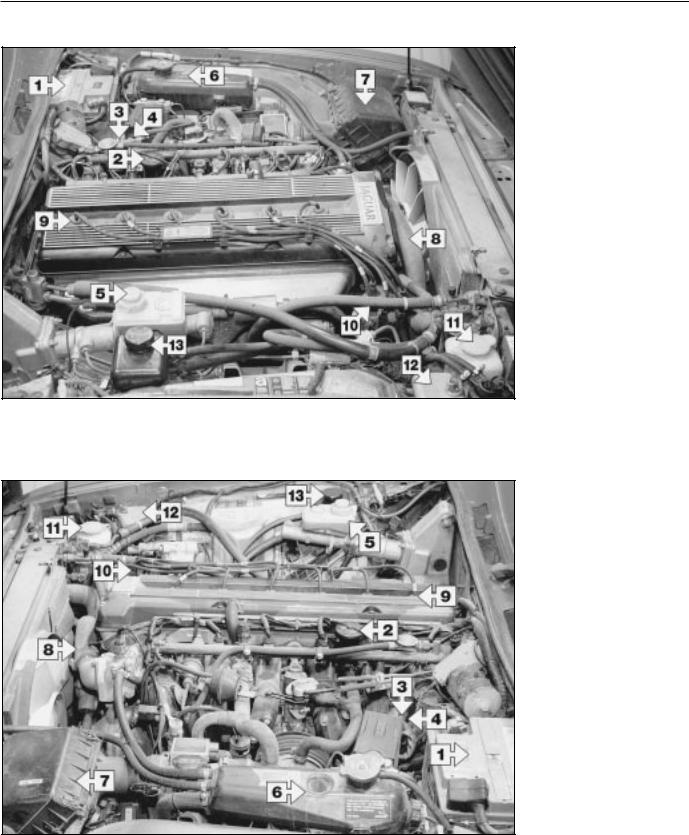
1•4 Maintenance - component location
Underbonnet view from the right-hand side of the vehicle
1 Battery
2 Oil filler cap
3 Engine oil dipstick (not visible)
4 Automatic transmission dipstick (not visible)
5 Brake fluid reservoir
6 Coolant reservoir (expansion tank)
7 Air cleaner housing
8 Upper radiator hose
9 Spark plugs
10 Distributor
11 Windscreen washer fluid reservoir
12 Power hydraulic system fluid reservoir
13 Power steering fluid reservoir
Underbonnet view from the left-hand side of the vehicle
1 Battery
2 Oil filler cap
3 Engine oil dipstick (not visible)
4 Automatic transmission dipstick (not visible)
5 Brake fluid reservoir
6 Coolant reservoir (expansion tank)
7 Air cleaner housing
8 Upper radiator hose
9 Spark plugs
10 Distributor
11 Windscreen washer fluid reservoir
12 Power hydraulic system fluid reservoir
13 Power steering fluid reservoir
3261 Jaguar XJ6
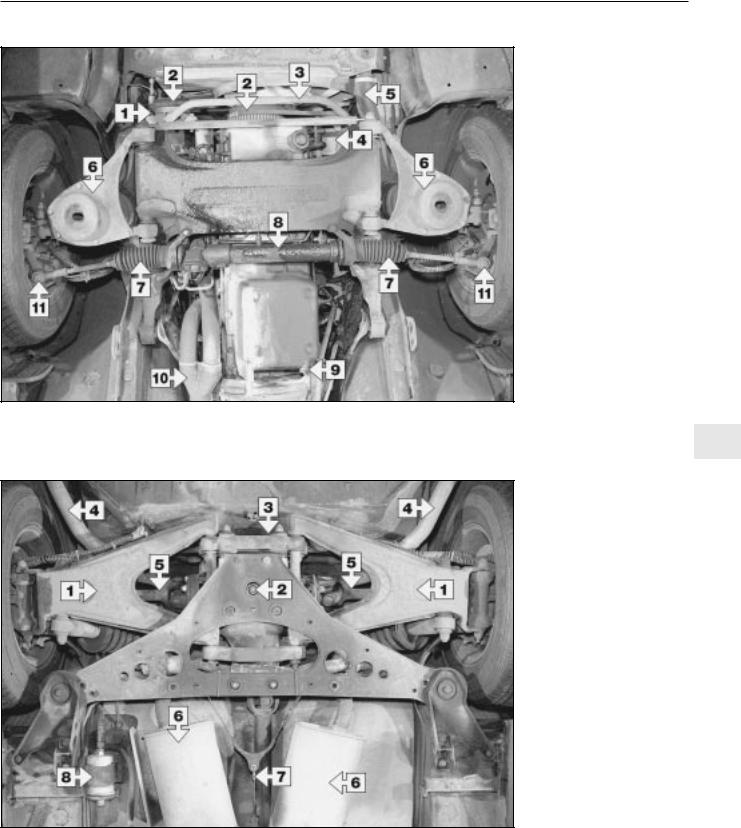
Maintenance - component location 1•5
Front underbody view
1 Air conditioning compressor
2 Drivebelts
3 Anti-roll bar
4 Alternator
5 Lower radiator hose
6 Lower control arm
7 Steering gear boot
8 Steering gear
9 Engine sump drain plug
10 Exhaust system
11 Outer tie-rod end
1
Rear underbody view (typical)
1 Rear suspension control arms
2 Differential drain plug
3 Differential filler plug (not visible)
4 Exhaust pipe
5 Driveshaft
6 Silencers
7 Handbrake cable
8 Fuel filter
3261 Jaguar XJ6
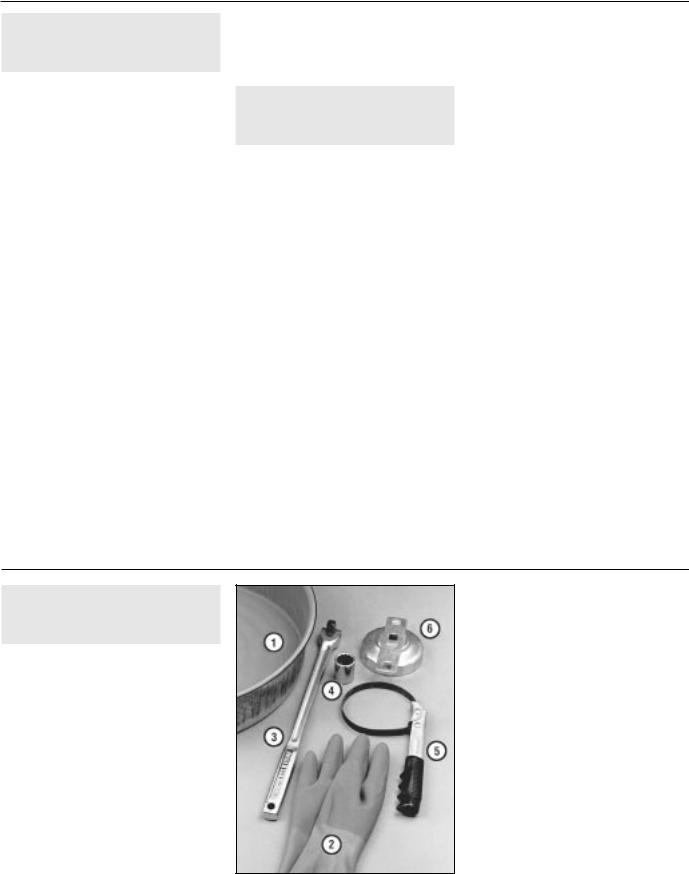
1•6 Maintenance procedures
1 General information
1This Chapter is designed to help the home mechanic maintain his/her vehicle for safety, economy, long life and peak performance.
2The Chapter contains a master maintenance schedule, followed by Sections dealing specifically with each task in the schedule. Visual checks, adjustments, component renewal and other helpful items are included. Refer to the accompanying illustrations of the engine compartment and the underside of the vehicle for the locations of the various components.
3Servicing your vehicle in accordance with the mileage/time maintenance schedule and the following Sections will provide a planned maintenance programme, which should result in a long and reliable service life. This is a comprehensive plan, so maintaining some items but not others at the specified service intervals, will not produce the same results.
4As you service your vehicle, you will discover that many of the procedures can - and should - be grouped together, because of the particular procedure being performed, or because of the proximity of two otherwiseunrelated components to one another. For example, if the vehicle is raised for any reason, the exhaust can be inspected at the same time as the suspension and steering components.
5The first step in this maintenance programme is to prepare yourself before the actual work begins. Read through all the
Sections relevant to the work to be carried out, then make a list and gather all the parts and tools required. If a problem is encountered, seek advice from a parts specialist, or a dealer service department.
2 Intensive maintenance
1 If, from the time the vehicle is new, the routine maintenance schedule is followed closely, and frequent checks are made of fluid levels and high-wear items, as suggested throughout this manual, the engine will be kept in relatively good running condition, and the need for additional work will be minimised.
2It is possible that there will be times when the engine is running poorly due to the lack of regular maintenance. This is even more likely if a used vehicle, which has not received regular and frequent maintenance checks, is purchased. In such cases, additional work may need to be carried out, outside of the regular maintenance intervals.
3If engine wear is suspected, a compression test (refer to Chapter 2) will provide valuable information regarding the overall performance of the main internal components. Such a test can be used as a basis to decide on the extent of the work to be carried out. If, for example, a compression test indicates serious internal engine wear, conventional maintenance as described in this Chapter will not greatly improve the performance of the engine, and may prove a waste of time and money, unless extensive overhaul work is carried out first.
4 The following series of operations are those which are most often required to improve the performance of a generally poor-running engine:
Primary operations
a)Clean, inspect and test the battery (Section 6).
b)Check all the engine-related fluids (refer to “Weekly checks”).
c)Check the condition and tension of the auxiliary drivebelt (Section 21).
d)Renew the spark plugs (Section 16).
e)Inspect the distributor cap and rotor arm (Section 19).
f)Check the condition of the air filter, and renew if necessary (Section 17).
g)Renew the fuel filter (Section 18).
h)Check the condition of all hoses, and check for fluid leaks (Section 7).
i)Check the exhaust gas emissions (see Chapter 6).
5 If the above operations do not prove fully effective, carry out the following secondary operations:
Secondary operations
All items listed under “Primary operations”, plus the following:
a)Check the charging system (refer to Chapter 5).
b)Check the ignition system (refer to Chapter 5).
c)Check the fuel system (refer to Chapter 4).
d)Renew the distributor cap and rotor arm (Section 19).
e)Renew the ignition HT leads (Section 19).
Every 7500 miles (12 000 km) or 6 months
3 Engine oil and filter renewal 2
1 Frequent oil changes are the best preventive maintenance the home mechanic can give the engine, because ageing oil becomes diluted and contaminated, which leads to premature engine wear.
2Make sure that you have all the necessary tools before you begin this procedure (see illustration). You should also have plenty of rags or newspapers handy for mopping up any spills.
3Access to the underside of the vehicle is greatly improved if the vehicle can be lifted on a hoist, driven onto ramps or supported by axle stands.
4If this is your first oil change, get under the vehicle and familiarise yourself with the location of the oil drain plug. The engine and
3.2 These tools are required when changing the engine oil and filter
1Drain pan - It should be fairly shallow in depth, but wide in order to prevent spills
2Rubber gloves - When removing the drain plug and filter, it is inevitable that you will get oil on your hands (the gloves will prevent burns)
3Breaker bar - Sometimes the oil drain plug is pretty tight and a long breaker bar is needed to loosen it
4Socket – To be used with the breaker bar or a ratchet (must be the correct size to fit the drain plug)
5Filter wrench - This is a metal band-type wrench, which requires clearance around the filter to be effective
6Filter wrench - This type fits on the bottom of the filter and can be turned with a ratchet or breaker bar (different size spanners are available for different types of filters)
3261 Jaguar XJ6
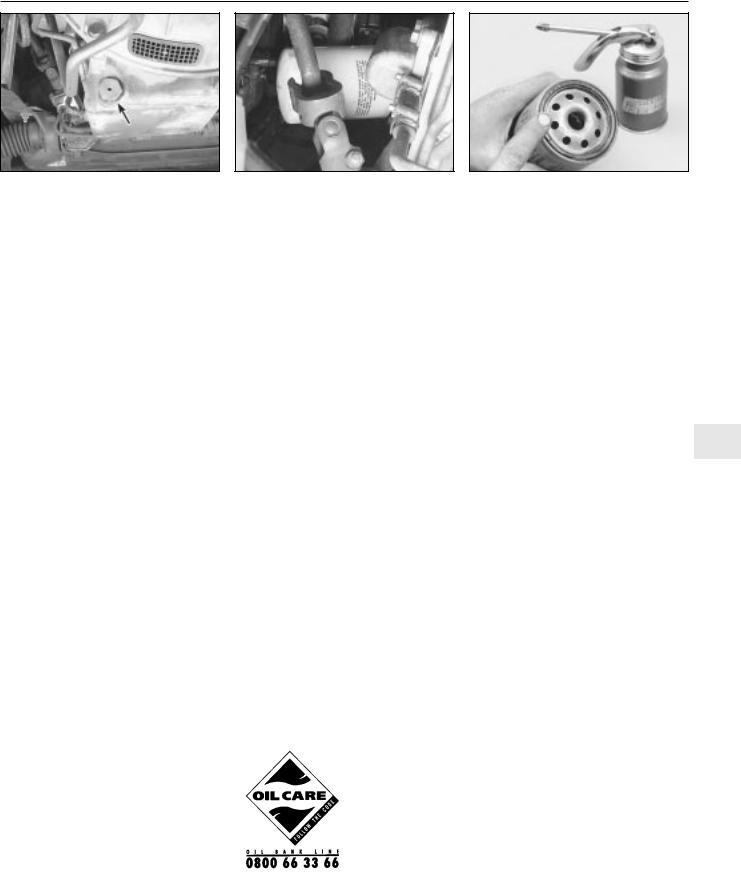
Every 7500 miles or 6 months 1•7
3.7 The oil drain plug (arrowed) is located at the rear of the sump - use a ring spanner or socket to remove it
exhaust components will be warm during the actual work, so try to anticipate any potential problems before the engine and accessories are hot.
5Park the vehicle on a level spot. Start the engine and allow it to reach its normal operating temperature (the needle on the temperature gauge should be at least above the bottom mark). Warm oil and contaminates will flow out more easily. Turn off the engine when it’s warmed up. Remove the oil filler cap located next to the valve cover.
6Raise the vehicle and support it on axle stands.
Warning: To avoid personal injury, never get beneath the vehicle when it is supported by only by a jack. The jack provided
with your vehicle is designed solely for raising the vehicle to remove and replace the wheels. Always use axle stands to support the vehicle when it becomes necessary to place your body underneath the vehicle.
7Being careful not to touch the hot exhaust components, place the drain pan under the drain plug in the bottom of the pan and remove the plug (see illustration). You may want to wear gloves while unscrewing the plug the final few turns if the engine is really hot.
8Allow the old oil to drain into the pan. It may be necessary to move the pan farther under the engine as the oil flow slows to a trickle. Inspect the old oil for the presence of metal shavings and chips.
9After all the oil has drained, wipe off the drain plug with a clean rag. Even minute metal particles clinging to the plug would immediately contaminate the new oil.
10Clean the area around the drain plug opening, refit the plug and tighten it securely, but do not strip the threads.
11Move the drain pan into position under the oil filter.
12Remove all tools, rags, etc. from under the vehicle, being careful not to spill the oil in the drain pan, then lower the vehicle.
13Loosen the oil filter (see illustration) by turning it anti-clockwise with the filter wrench. Any standard filter wrench should work. Once
3.13 The oil filter is located on the left side of the engine - use a filter wrench for removal (tighten the new filter by hand)
the filter is loose, use your hands to unscrew it from the block. Just as the filter comes away from the block, immediately tilt the open end up to prevent the oil inside the filter from spilling out.
Warning: The engine exhaust pipes may still be hot, so be careful.
14With a clean rag, wipe off the mounting surface on the block. If a residue of old oil is allowed to remain, it will smoke when the block is heated up. It will also prevent the new filter from seating properly. Also make sure that the none of the old gasket remains stuck to the mounting surface. It can be removed with a scraper if necessary.
15Compare the old filter with the new one to make sure they are the same type. Smear some engine oil on the rubber gasket of the new filter and screw it into place (see illustration). Because over-tightening the
filter will damage the gasket, do not use a filter wrench to tighten the filter. Tighten it by hand until the gasket contacts the seating surface. Then seat the filter by giving it an additional 3/4-turn.
16Add new oil to the engine through the oil filler cap next to the valve cover. Use a spout or funnel to prevent oil from spilling onto the top of the engine. Pour three litres of fresh oil into the engine. Wait a few minutes to allow the oil to drain into the pan, then check the level on the oil dipstick (see “Weekly checks”). If the oil level is at or near the H mark, refit the filler cap hand tight, start the engine and allow the new oil to circulate.
17Allow the engine to run for about a minute. While the engine is running, look under the vehicle and check for leaks at the sump drain plug and around the oil filter. If either is
Note: It is antisocial and illegal to dump oil down the drain. To find the location of your local oil recycling bank, call this number free.
3.15 Lubricate the oil filter gasket with clean engine oil before refitting the filter
leaking, stop the engine and tighten the plug or filter slightly.
18Wait a few minutes to allow the oil to trickle down into the pan, then recheck the level on the dipstick and, if necessary, add enough oil to bring the level to the H mark.
19During the first few trips after an oil change, make it a point to check frequently for leaks and proper oil level.
20The old oil drained from the engine cannot be reused in its present state and should be disposed of. Check with your local authority, or with a local garage to see whether they will accept the oil for recycling. Don’t pour used oil into drains or onto the ground. After the oil has cooled, it can be drained into a suitable
container (capped plastic jugs, topped 1 bottles, etc.) for transport to an approved disposal site.
4 Spark plug check |
2 |
|
|
|
|
1Spark plug renewal requires a spark plug socket which fits onto a ratchet spanner. This socket is lined with a rubber grommet to protect the porcelain insulator of the spark plug and to hold the plug while you insert it into the spark plug hole. You will also need a wire-type feeler gauge to check and adjust the spark plug gap and a torque wrench to tighten the new plugs to the specified torque
(see illustration).
2If you are replacing the plugs, purchase the new plugs, adjust them to the proper gap and then replace each plug one at a time. Note:
When buying new spark plugs, it’s essential that you obtain the correct plugs for your specific vehicle. This information can be found in the Specifications Section at the beginning of this Chapter, on the Vehicle Emissions Control Information (VECI) label located on the underside of the bonnet (where fitted)or in the owner’s manual. If these sources specify different plugs, purchase the spark plug type specified on the VECI label because that information is provided specifically for your engine.
3261 Jaguar XJ6
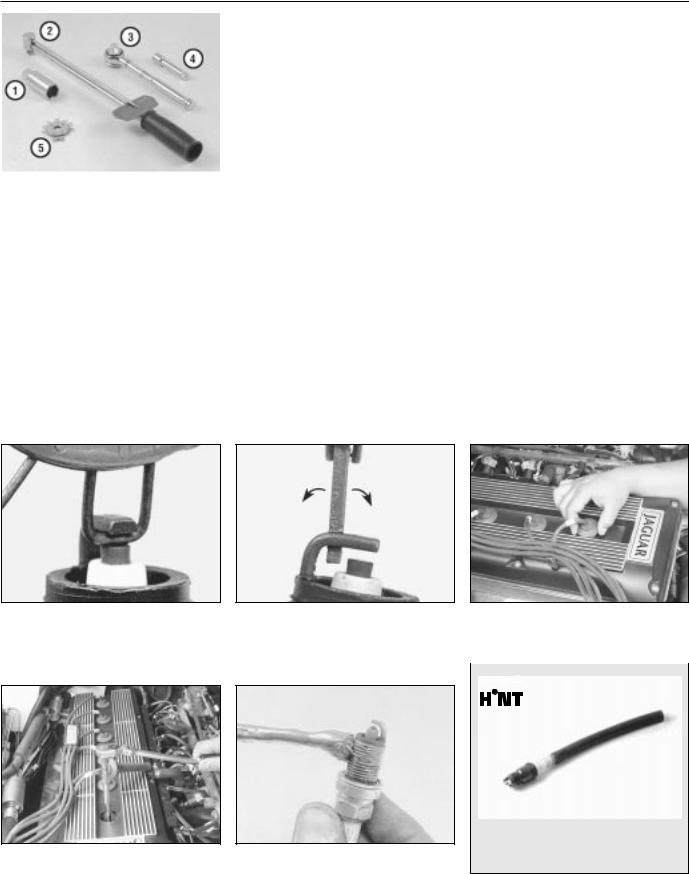
1•8 Every 7500 miles or 6 months
|
1 |
Spark plug socket - This will have special |
|
|
|
padding inside to protect the spark plug |
|
|
|
porcelain insulator |
|
|
2 |
Torque wrench - Although not mandatory, |
|
|
|
use of this tool is the best way to ensure |
|
|
|
that the plugs are tightened properly |
|
|
3 |
Ratchet - to fit the plug socket |
|
|
4 |
Extension - Depending on model and |
|
|
|
accessories, you may need special |
|
|
|
extensions and universal joints to reach |
|
|
|
one or more of the plugs |
|
|
5 |
Spark plug gap gauge - This gauge for |
|
|
|
checking the gap comes in a variety of |
|
4.1 Tools required for changing |
|||
styles. Make sure the gap for your engine |
|||
spark plugs |
is included |
||
|
|
|
|
3Inspect each of the new plugs for defects. If there are any signs of cracks in the porcelain insulator of a plug, don’t use it.
4Check the electrode gaps of the new plugs. Check the gap by inserting the wire gauge of the proper thickness between the electrodes at the tip of the plug (see illustration). The gap between the electrodes should be identical to that listed in this Chapter’s Specifications or on the VECI label (as applicable). If the gap is incorrect, use the notched adjuster on the feeler gauge body to bend the curved side electrode slightly (see illustration).
5If the side electrode is not exactly over the centre electrode, use the notched adjuster to align them.
Caution: If the gap of a new plug must be adjusted, bend only the base of the earth electrode - do not touch the tip.
Removal
6 To prevent the possibility of mixing up spark plug leads, work on one spark plug at a time. Remove the lead and boot from one spark plug. Grasp the boot - not the lead - as shown, give it a half twisting motion and pull straight up (see illustration).
7If compressed air is available, blow any dirt or foreign material away from the spark plug area before proceeding (a common bicycle pump will also work).
8Remove the spark plug (see illustration).
9 Whether you are replacing the plugs at this time or intend to re-use the old plugs, compare each old spark plug with the chart shown on the inside back cover of this manual to determine the overall running condition of the engine.
Refitting
10Prior to refitting, apply a coat of anti-seize compound to the plug threads (see illustration). It’s often difficult to insert spark plugs into their holes without cross-threading them. To avoid this possibility, fit a short piece of 3/8-inch internal diameter (ID) rubber hose over the end of the spark plug (see Haynes Hint). The flexible hose acts as a universal joint to help align the plug with the plug hole. Should the plug begin to cross-thread, the hose will slip on the spark plug, preventing thread damage. Tighten the plug to the torque listed in this Chapter’s Specifications. In the absence of a torque wrench, tighten each plug until you feel it seat, and then by a further quarter-turn only. Do not overtighten the spark plugs.
11Attach the plug lead to the new spark plug, again using a twisting motion on the boot until it is firmly seated on the end of the spark plug.
12Follow the above procedure for the remaining spark plugs, replacing them one at a time to prevent mixing up the spark plug leads.
4.4a Spark plug manufacturers |
4.4b To change the gap, bend the side |
4.6 When removing the spark plug leads, |
||||
recommend using a wire-type gauge when |
electrode only, as indicated by the arrows, |
|
|
grasp only the boot and use a |
||
checking the gap - if the wire does not |
and be very careful not to crack or chip the |
|
|
twisting/pulling motion |
||
slide between the electrodes with a slight |
porcelain insulator surrounding the |
|
|
|
|
|
drag, adjustment is required |
centre electrode |
|
|
|
|
|
|
|
|
|
|
||
|
|
|
|
|
|
|
|
|
|
|
|
|
|
|
|
|
|
|
|
|
|
|
|
|
|
|
|
|
|
|
|
|
|
|
|
|
|
|
|
|
|
|
|
|
|
|
|
|
4.8 Use a spark plug socket with a long extension to unscrew the spark plugs
4.10 Apply a coat of anti-seize compound to the spark plug threads
A length of 3/8-inch ID rubber hose will save time and prevent damaged threads when refitting the spark plugs
3261 Jaguar XJ6
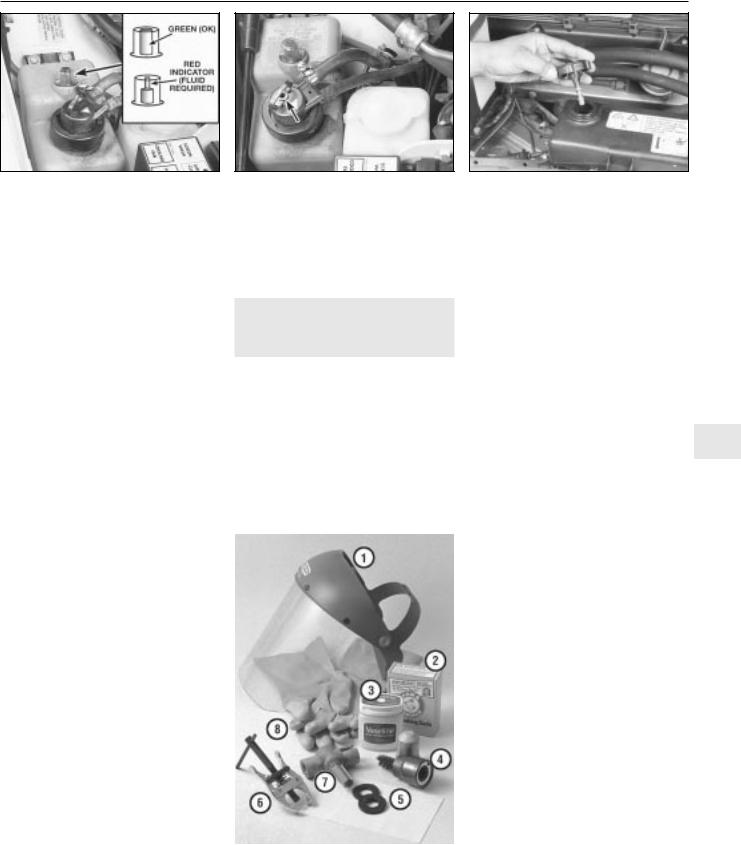
Every 7500 miles or 6 months 1•9
5.2 The power hydraulic system reservoir |
5.3 To add fluid, remove the filler hole |
is located on the right-hand inner wing - |
dust cap (arrowed) |
to check the fluid level on 1988 and 1989 |
|
models simply look through the sight glass |
|
and note the colour of the indicator |
|
5.7 On 1990 and later models remove the cap and check the fluid level on the dipstick
5 Power hydraulic system |
1 |
|
fluid level check |
||
|
||
|
|
Caution: Use only Castrol or Jaguar hydraulic system mineral oil (HSMO) in the power hydraulic system (available at Jaguar dealer service departments).
1 The power hydraulic system controls the ride levelling and the brake servo systems. The fluid reservoir also supplies the power steering system on some models. The level of the fluid should be carefully maintained. Low fluid levels can adversely affect the riding and braking capabilities of your vehicle. The power hydraulic system fluid reservoir is located on the right inner wing of the engine compartment.
1988 and 1989 models
2 The fluid level can easily be checked by viewing the reservoir sight glass. A green indicator in the sight glass indicates an OK condition, while a red indicator in the sight glass requires fluid to be added (see illustration).
3If additional fluid is required, pop open the plastic tab located on top of the reservoir cap
(see illustration).
4Insert the mineral oil dispensing tube into the reservoir filler hole. Push down and turn until the dispensing tube is locked in place.
5Add fluid until the green indicator in the sight glass appears, then release the dispensing tube by pushing downward and turning the opposite direction of refitting.
1990 to 1994 models
6The fluid level can be checked by removing the cap and observing the level of fluid on the dipstick.
7Wipe off the fluid with a clean rag, reinsert it, then withdraw it and read the fluid level (see illustration). The dipstick is marked so the fluid can be checked either cold or hot. The level should be at the HOT mark if the fluid was hot to the touch. It should be at the COLD mark if the fluid was cool to the touch. At no time should the fluid level drop below the add mark.
8 If additional fluid is required, pour the specified type directly into the reservoir, using a funnel to prevent spills.
6 Battery check |
1 |
and general information |
Warning: Certain precautions must be followed when working with the battery. Hydrogen gas, which is highly flammable, is
always present in the battery cells, so don’t smoke, and keep naked flames and sparks away from the battery. The electrolyte in the battery is actually dilute sulphuric acid, which will cause injury if splashed on your skin or in your eyes. It will also ruin clothes and painted surfaces. When removing the battery cables, always detach the negative cable first and hook it up last!
1A routine preventive maintenance program for the battery in your vehicle is the only way to ensure quick and reliable starts. But before performing any battery maintenance, make sure that you have the proper equipment necessary to work safely around the battery
(see illustration).
2There are also several precautions that should be taken whenever battery maintenance is performed. Before servicing the battery, always turn the engine and all accessories off and disconnect the cable from the negative terminal of the battery.
3The battery produces hydrogen gas, which
is both flammable and explosive. Never create 1 a spark, smoke or light a match around the battery. Always charge the battery in a ventilated area.
4 Electrolyte contains poisonous and corrosive sulphuric acid. Do not allow it to get in your eyes, on your skin or on your clothes, and
|
|
1 |
Face shield/safety goggles - When |
|
|
|
removing corrosion with a brush, the |
|
|
|
acidic particles can fly up into your eyes |
|
|
2 |
Baking soda - A solution of baking soda |
|
|
|
and water can be used to neutralise |
|
|
|
corrosion |
|
|
3 |
Petroleum jelly - A layer of this on the |
|
|
|
battery posts will help prevent corrosion |
|
|
4 |
Battery post/cable cleaner - This wire |
|
|
|
brush cleaning tool will remove all traces |
|
|
|
of corrosion from the battery posts and |
|
|
|
cable clamps |
|
|
5 |
Treated felt washers - Placing one of |
|
|
|
these on each post, directly under the |
|
|
|
cable clamps, will help prevent corrosion |
|
|
6 |
Puller - Sometimes the cable clamps are |
|
|
|
difficult to pull off the posts, even after the |
|
|
|
nut/bolt has been completely loosened. |
|
|
|
This tool pulls the clamp straight up and |
|
|
|
off the post without damage |
|
|
7 |
Battery post/cable cleaner - Here is |
|
|
|
another cleaning tool which is a slightly |
|
|
|
different version of number 4 above, but |
|
|
|
it does the same thing |
|
|
8 |
Rubber gloves - Another safety item to |
6.1 Tools and materials required for |
|
consider when servicing the battery; |
|
battery maintenance |
|
remember that’s acid inside the battery! |
|
|
|
|
|
3261 Jaguar XJ6
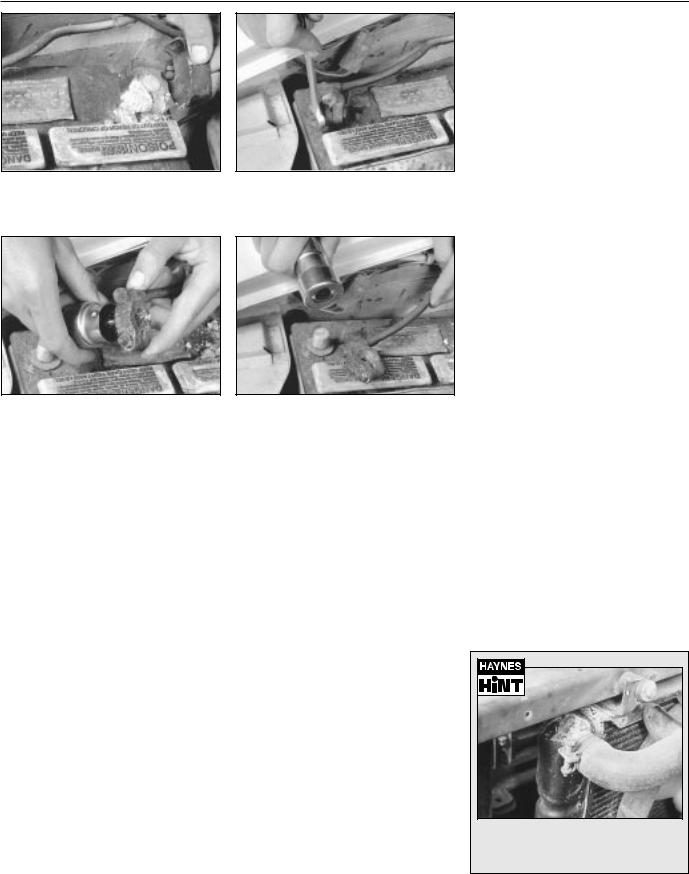
1•10 Every 7500 miles or 6 months
6.6a Battery terminal corrosion usually appears as light, fluffy powder
6.7a Remove all the corrosion from the cable clamps (the inside of the clamp is tapered to match the taper on the post, so don’t remove too much material)
never ingest it. Wear protective safety glasses when working near the battery. Keep children away from the battery.
5Note the external condition of the battery. If the positive terminal and cable clamp on your vehicle’s battery is equipped with a rubber protector, make sure it isn’t torn or damaged. It should completely cover the terminal. Look for any corroded or loose connections, cracks in the case or cover or loose hold-down clamps. Also check the entire length of each cable for cracks and frayed conductors.
6If corrosion, which looks like white, fluffy deposits (see illustration) is evident, particularly around the terminals, the battery should be removed for cleaning. Loosen the cable clamp bolts, being careful to remove the ground cable first, and slide them off the terminals (see illustration). Then disconnect the hold-down clamp bolt and nut, remove the clamp and lift the battery from the engine compartment.
7Clean the cable clamps thoroughly with a battery brush or a terminal cleaner and a solution of warm water and baking soda (see illustration). Wash the terminals and the top of the battery case with the same solution but make sure that the solution doesn’t get into the battery. When cleaning the cables, terminals and battery top, wear safety goggles and rubber gloves to prevent any solution from coming in contact with your eyes or hands. Wear old clothes too - even
6.6b Removing a cable from the battery post with a spanner - sometimes special battery pliers are required for this if corrosion has damaged the nut hex
clean the battery posts, a clean, shiny surface should be the result
diluted, sulphuric acid splashed onto clothes will burn holes in them. If the terminals have been extensively corroded, clean them up with a terminal cleaner (see illustration). Thoroughly wash all cleaned areas with plain water.
8 Make sure the battery tray is in good condition and the hold-down clamp bolt or nut is tight. If the battery is removed from the tray, make sure no parts remain in the bottom of the tray when the battery is reinstalled. When reinstalling the hold-down clamp bolt or nut, do not over-tighten it.
9 Information on removing and refitting the battery can be found in Chapter 5. Information on jump starting can be found at the front of this manual.
Cleaning
10Corrosion on the hold-down components, battery case and surrounding areas can be removed with a solution of water and baking soda. Thoroughly rinse all cleaned areas with plain water.
11Any metal parts of the vehicle damaged by corrosion should be covered with a zincbased primer, then painted.
Charging
Warning: When batteries are being charged, hydrogen gas, which is very explosive and flammable, is produced. Do not
smoke or allow open flames near a charging or a recently charged battery. Wear eye protection when near the battery during charging. Also, make sure the charger is unplugged before connecting or disconnecting the battery from the charger.
12Slow-rate charging is the best way to restore a battery that’s discharged to the point where it will not start the engine. It’s also a good way to maintain the battery charge in a vehicle that’s only driven a few miles between starts. Maintaining the battery charge is particularly important in the winter when the battery must work harder to start the engine and electrical accessories that drain the battery are in greater use.
13It’s best to use a one or two-amp battery charger (sometimes called a “trickle” charger). They are the safest and put the least strain on the battery. They are also the least expensive. For a faster charge, you can use a higher amperage charger, but don’t use one rated more than 1/10th the amp/hour rating of the battery. Rapid boost charges that claim to restore the power of the battery in one to two hours are hardest on the battery and can damage batteries not in good condition. This type of charging should only be used in emergency situations.
14The average time necessary to charge a battery should be listed in the instructions that come with the charger. As a general rule, a trickle charger will charge a battery in 12 to 16 hours.
7 Hose and fluid leak check |
1 |
|
|
1 Visually inspect the engine joint faces, gaskets and seals for any signs of water or oil leaks. Pay particular attention to the areas around the camshaft cover, cylinder head, oil filter and sump joint faces. Bear in mind that, over a period of time, some very slight seepage from these areas is to be expected - what you are really looking for is any indication of a serious leak (see Haynes Hint). Should a
A leak in the cooling system will usually show up as white - or rust-coloured - deposits on the area adjoining the leak
3261 Jaguar XJ6
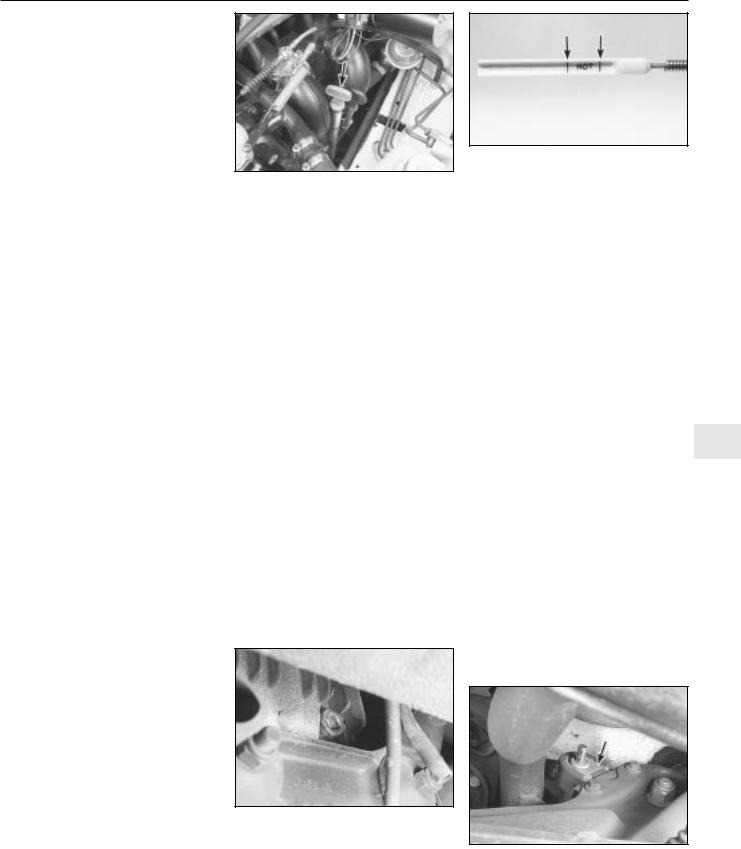
Every 7500 miles or 6 months 1•11
leak be found, renew the offending gasket or oil seal by referring to the appropriate Chapters in this manual.
2Also check the security and condition of all the engine-related pipes and hoses. Ensure that all cable ties or securing clips are in place and in good condition. Clips which are broken or missing can lead to chafing of the hoses, pipes or wiring, which could cause more serious problems in the future.
3Carefully check the radiator hoses and heater hoses along their entire length. Renew any hose which is cracked, swollen or deteriorated. Cracks will show up better if the hose is squeezed. Pay close attention to the hose clips that secure the hoses to the cooling system components. Hose clips can pinch and puncture hoses, resulting in cooling system leaks.
4Inspect all the cooling system components (hoses, joint faces etc.) for leaks. A leak in the cooling system will usually show up as whiteor rust-coloured deposits on the area adjoining the leak. Where any problems of this nature are found on system components, renew the component or gasket with reference to Chapter 3.
5From within the engine compartment, check the security of all fuel hose attachments and pipe unions, and inspect the fuel hoses and vacuum hoses for kinks, chafing and deterioration.
6Also check the condition of the power steering fluid hoses and pipes.
8 Automatic transmission |
1 |
fluid level check |
|
|
|
1The level of the automatic transmission fluid should be carefully maintained. Low fluid level can lead to slipping or loss of drive, while overfilling can cause foaming, loss of fluid and transmission damage.
2The transmission fluid level should only be checked when the transmission is at its normal operating temperature.
Caution: If the vehicle has just been driven for a long time at high speed or in city traffic in hot weather, or if it has been pulling a trailer, an accurate fluid level reading cannot be obtained. Allow the fluid to cool down for about 30 minutes.
3If the vehicle has not been driven, park the vehicle on level ground, set the handbrake, then start the engine and bring it to operating temperature. While the engine is idling, depress the brake pedal and move the selector lever through all the gear ranges, beginning and ending in Park.
4With the engine still idling, remove the dipstick from its tube (see illustration). Check the level of the fluid on the dipstick (see illustration) and note its condition.
5Wipe the fluid from the dipstick with a clean rag and reinsert it back into the filler tube until the cap seats.
8.4a The automatic transmission dipstick (arrowed) is located in a tube which extends forward from the transmission
6Pull the dipstick out again and note the fluid level. If the transmission is cold, the level should be in the COLD or COOL range on the dipstick. If it is hot, the fluid level should be in the HOT range. If the level is at the low side of either range, add the specified transmission fluid through the dipstick tube with a funnel.
7Add just enough of the recommended fluid to fill the transmission to the proper level. It takes about one pint to raise the level from the low mark to the high mark when the fluid is hot, so add the fluid a little at a time and keep checking the level until it is correct.
8The condition of the fluid should also be checked along with the level. If the fluid at the end of the dipstick is black or a dark reddish brown colour, or if it emits a burned smell, the fluid should be changed (see Section 26). If you are in doubt about the condition of the fluid, purchase some new fluid and compare the two for colour and smell.
9 Differential oil level check |
1 |
|
|
1 The differential has a check/fill plug which must be removed to check the lubricant level. If the vehicle is raised to gain access to the plug, be sure to support it safely on axle stands - DO NOT crawl under the vehicle when it’s supported only by the jack!
9.2 The differential check/fill plug is located on the rear of the differential housing - place your finger in the filler plug hole to make sure the lubricant level is even with the bottom of the hole
8.4b Check the automatic transmission fluid with the engine idling at operating temperature and the gear selector in Park, then add fluid to bring the level to the upper mark
2Remove the lubricant check/fill plug from the differential (see illustration). Use a 3/8-inch drive ratchet and a short extension to unscrew the plug.
3Use your little finger as a dipstick to make sure the lubricant level is even with the bottom of the plug hole. If not, use a syringe or squeeze bottle to add the recommended lubricant until it just starts to run out of the opening.
4Refit the plug and tighten it securely.
10 Exhaust system check |
1 |
|
|
|
|
1 With the engine cold (at least three hours 1 after the vehicle has been driven), check the complete exhaust system from its starting point at the engine to the end of the tailpipe. This should be done on a hoist where unrestricted access is available.
2 Check the pipes and connections for evidence of leaks, severe corrosion or damage. Make sure that all brackets and hangers are in good condition and tight (see illustration).
3At the same time, inspect the underside of the body for holes, corrosion, open seams, etc. which may allow exhaust gases to enter the passenger compartment. Seal all body openings with silicone or body putty.
4Rattles and other noises can often be traced to the exhaust system, especially the mounts and hangers. Try to move the pipes,
10.2 Check the exhaust system hangers (arrowed) for damage and cracks
3261 Jaguar XJ6
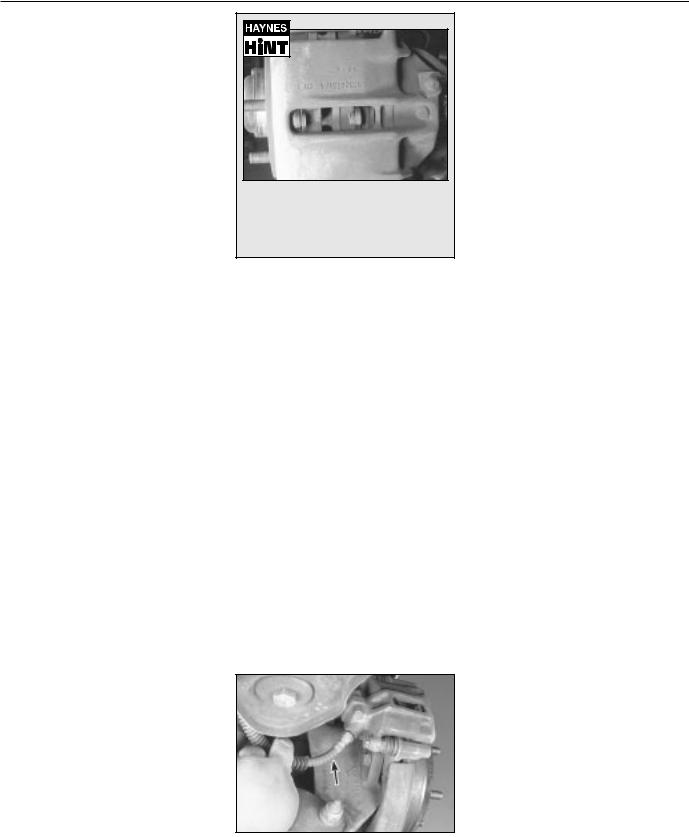
1•12 Every 7500 miles or 6 months
silencer and catalytic converter. If the components can come in contact with the body or suspension parts, secure the exhaust system with new mounts.
5 Check the running condition of the engine by inspecting inside the end of the tailpipe. The exhaust deposits here are an indication of engine state-of-tune. If the pipe is black and sooty or coated with white deposits, the engine is in need of a tune-up, including a thorough fuel system inspection.
11 Braking system - general |
2 |
check and adjustment |
|
|
|
Warning: The dust created by the brake system may contain asbestos, which is harmful to your health. Never blow it out
with compressed air and don’t inhale any of it. An approved filtering mask should be worn when working on the brakes. Do not, under any circumstances, use petroleumbased solvents to clean brake parts. Use brake system cleaner only! Try to use nonasbestos replacement parts whenever possible.
Note: For detailed photographs of the brake system, refer to Chapter 9.
1 In addition to the specified intervals, the brakes should be inspected every time the wheels are removed or whenever a defect is suspected. Any of the following symptoms could indicate a potential brake system defect: The vehicle pulls to one side when the brake pedal is depressed; the brakes make squealing or dragging noises when applied; brake pedal travel is excessive; the pedal pulsates; brake fluid leaks, usually onto the inside of the tyre or wheel.
2The disc brakes have built-in electrical wear indicators which cause a warning lamp to illuminate on the instrument panel when they’re worn to the renewal point. When the warning light comes on, replace the pads immediately or expensive damage to the discs can result.
3Loosen the wheel nuts.
4Raise the vehicle and place it securely on axle stands.
5Remove the wheels.
Disc brakes
6There are two pads (an outer and an inner) in each caliper. The pads are visible through inspection holes in each caliper (see Haynes Hint).
7Check the pad thickness by looking at each end of the caliper and through the inspection hole in the caliper body. If the lining material is less than the thickness listed in this Chapter’s Specifications, replace the pads. Note: Keep in mind that the lining material is riveted or bonded to a metal backing plate and the metal portion is not included in this measurement.
You will find an inspection hole like this in each caliper - placing a ruler across the hole should enable you to determine the thickness of remaining pad material for both inner and outer pads
8 If it is difficult to determine the exact thickness of the remaining pad material by the above method, or if you are at all concerned about the condition of the pads, remove the caliper(s), then remove the pads from the calipers for further inspection (see Chapter 9). 9 Once the pads are removed from the calipers, clean them with brake cleaner and re-measure them with a ruler or a vernier caliper.
10 Measure the disc thickness with a micrometer to make sure that it still has service life remaining. If any disc is thinner than the specified minimum thickness, replace it (refer to Chapter 9). Even if the disc has service life remaining, check its condition. Look for scoring, gouging and burned spots. If these conditions exist, remove the disc and have it resurfaced (see Chapter 9).
11 Before refitting the wheels, check all brake lines and hoses for damage, wear, deformation, cracks, corrosion, leakage, bends and twists, particularly in the vicinity of the rubber hoses at the calipers (see illustration). Check the clamps for tightness and the connections for leakage. Make sure that all hoses and lines are clear of sharp edges, moving parts and the exhaust system. If any of the above conditions are noted, repair, reroute or replace the lines and/or fittings as necessary (see Chapter 9).
11.11 Check along the brake hoses and at each fitting (arrowed) for deterioration and cracks
Hydraulic brake servo check
12Sit in the driver’s seat and perform the following sequence of tests.
13Start the engine, run it for about a minute and turn it off. Then firmly depress the brake several times - the pedal travel should decrease with each application.
14With the brake fully depressed, start the engine - the pedal should move down a little when the engine starts.
15Depress the brake, stop the engine and hold the pedal in for about 30 seconds - the pedal should neither sink nor rise.
16If your brakes do not operate as described above when the preceding tests are performed, the brake servo is either in need of repair or has failed. Refer to Chapter 9 for the removal procedure.
Handbrake
17 Slowly pull up on the handbrake and count the number of clicks you hear until the handle is up as far as it will go. The adjustment should be within the specified number of clicks listed in this Chapter’s Specifications. If you hear more or fewer clicks, it’s time to adjust the handbrake (refer to Chapter 9).
18 An alternative method of checking the handbrake is to park the vehicle on a steep hill with the handbrake set and the transmission in Neutral (be sure to stay in the vehicle during this check!). If the handbrake cannot prevent the vehicle from rolling, it is in need of adjustment (see Chapter 9). Whenever a fault is suspected, the brake discs should be removed and the handbrake assemblies themselves should be visually inspected.
12 Steering |
2 |
and suspension check |
|
|
|
Note: The steering linkage and suspension components should be checked periodically. Worn or damaged suspension and steering linkage components can result in excessive and abnormal tyre wear, poor ride quality and vehicle handling and reduced fuel economy. For detailed illustrations of the steering and suspension components, refer to Chapter 10.
With the wheels on the ground
1Park the vehicle on level ground, turn the engine off and set the handbrake. Check the tyre pressures and check that the wheel nuts are tightened to the specified torque.
2Push down at one corner of the vehicle, then release it while noting the movement of the body. It should stop moving and come to rest in a level position with one or two bounces. When bouncing the vehicle up and down, listen for squeaks and noises from the suspension components.
3If the vehicle continues to move up-and- down or if it fails to return to its original
3261 Jaguar XJ6
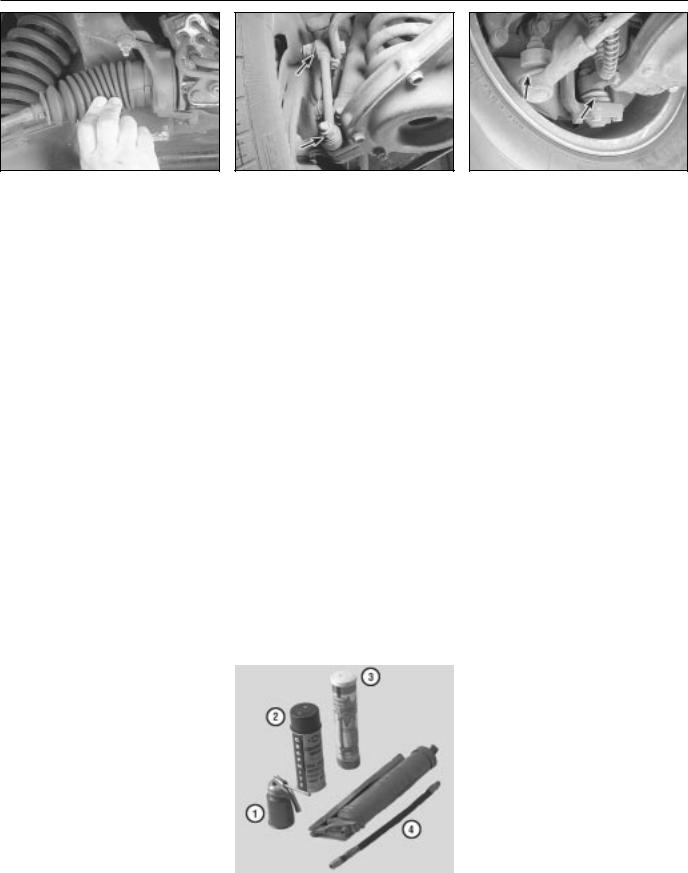
Every 7500 miles or 6 months 1•13
12.8a Check the steering gear dust boots for cracks and leaking steering fluid
position, a worn or weak shock absorber is probably the reason.
4 Repeat the above check at each of the three remaining corners of the vehicle.
Under the vehicle
5 Raise the vehicle with a trolley jack and support it securely on axle stands. See
“Jacking and towing” for proper jacking points.
6Check the shock absorbers for evidence of fluid leakage. Make sure that any fluid noted is from the shocks and not from any other source. Also check the rubber mounts at each end for deterioration If the shock absorbers fail any of the tests above replace the shocks as a set.
7Check the tyres for irregular wear patterns and proper inflation. See “Weekly checks” for information regarding tyre wear.
8Inspect the universal joint between the steering shaft and the steering gear housing. Check the steering gear housing for grease leakage. Make sure that the dust seals and boots are not damaged and that the boot clamps are not loose (see illustration). Check the steering linkage for looseness or damage. Look for loose bolts, broken or disconnected parts and deteriorated rubber bushings on all suspension and steering components (see illustration). While an assistant turns the steering wheel from side to side, check the steering components for free movement, chafing and binding. If the steering components do not seem to be reacting with the movement of the steering wheel, try to determine where the slack is located.
9Check the balljoints moving each lower arm up and down with a crowbar to ensure that its balljoint has no play. If any balljoint does have play, replace it. See Chapter 10 for the front balljoint renewal procedure. Check the tie-rod ends for excessive play.
10Inspect the balljoint and tie-rod end boots for damage and leaking grease (see illustration. Replace the balljoints and tie-rod ends with new ones if they are damaged (see Chapter 10).
12.8b Check the anti-roll bar bushings |
12.10 Inspect the balljoint and tie-rod end |
|
||||
(arrowed) for deterioration at the front and |
boots for tears - tears or damage in either |
|
||||
the rear of the vehicle |
|
|
boot will allow contamination of the grease |
|
||
|
|
|
|
which will lead to premature failure |
|
|
|
|
|
plugs will be installed rather than grease |
|
||
13 Seat belt check |
1 |
|
|
|||
|
fittings. If so, grease fittings will have to be |
|
||||
|
|
purchased and installed. |
|
|||
|
|
2 |
Look under the car and see if grease fittings |
|
||
|
|
|
or plugs are installed. If there are plugs, |
|
||
1 Check the seat belts, buckles, latch plates |
remove them and buy grease fittings, which |
|
||||
and guide loops for any obvious damage or |
will thread into the component. A dealer or |
|
||||
signs of wear. |
|
|
motor factors will be able to supply the |
|
||
2 Make sure the seat belt reminder light |
correct fittings. Straight, as well as angled, |
|
||||
comes on when the key is turned on. |
|
|
fittings are available. |
|
||
3 The seat belts are designed to lock up |
3 |
For easier access under the car, raise it with |
|
|||
during a sudden stop or impact, yet allow free |
a jack and place axle stands under the |
|
||||
movement during normal driving. The |
chassis. Make sure it’s safely supported by |
|
||||
retractors should hold the belt against your |
the stands. If the wheels are to be removed at |
|
||||
|
||||||
chest while driving and rewind the belt when |
this interval for tyre rotation or brake |
1 |
||||
the buckle is unlatched. |
|
|
inspection, loosen the wheel nuts slightly |
|||
4 If any of the above checks reveal problems |
while the car is still on the ground. |
|
||||
with the seat-belt system, replace parts as |
4 |
Before beginning, force a little grease out of |
|
|||
necessary. Note: Check with your local dealer |
the nozzle to remove any dirt from the end of |
|
||||
service department; the seat belt system |
the gun. Wipe the nozzle clean with a rag. |
|
||||
should be covered under the factory warranty. |
5 |
With the grease gun and plenty of clean |
|
|||
|
|
|
rags, crawl under the car and begin |
|
||
14 General lubrication |
2 |
|
lubricating all the front suspension parts that |
|
||
|
are equipped with a grease fitting. |
|
||||
|
|
6 |
Lubricate the rear driveshafts (see |
|
||
|
|
illustration). Wipe each fitting clean and push |
|
|||
|
|
|
the nozzle firmly over it. Pump the gun until |
|
||
1 Obtain a good quality, multi-purpose |
|
|||||
grease is expelled from the U-joint cap seal. |
|
|||||
lithium-base grease. You’ll also need a grease |
7 |
Wipe away any excess grease from the |
|
|||
gun and other materials to properly lubricate |
components and the grease fitting. Repeat |
|
||||
the chassis (see illustration). Occasionally |
the procedure for the remaining fittings. |
|
||||
|
|
|
|
|
|
|
|
|
|
|
14.1 Materials required for chassis |
|
|
|
|
|
|
and body lubrication |
|
|
|
|
|
|
|
|
|
|
|
|
1 |
Engine oil - Light engine oil in a can like |
|
|
|
|
|
|
this can be used for door and bonnet |
|
|
|
|
|
|
hinges |
|
|
|
|
|
2 |
Graphite spray - Used to lubricate lock |
|
|
|
|
|
|
cylinders |
|
|
|
|
|
3 |
Grease - Grease, in a variety of types and |
|
|
|
|
|
|
weights, is available for use in a grease |
|
|
|
|
|
|
gun. |
|
|
|
|
|
4 |
Grease gun - A common grease gun, |
|
|
|
|
|
|
shown here with a detachable hose and |
|
|
|
|
|
|
nozzle, is needed for chassis lubrication. |
|
|
|
|
|
|
After use, clean it thoroughly |
|
|
|
|
|
|
|
|
|
3261 Jaguar XJ6
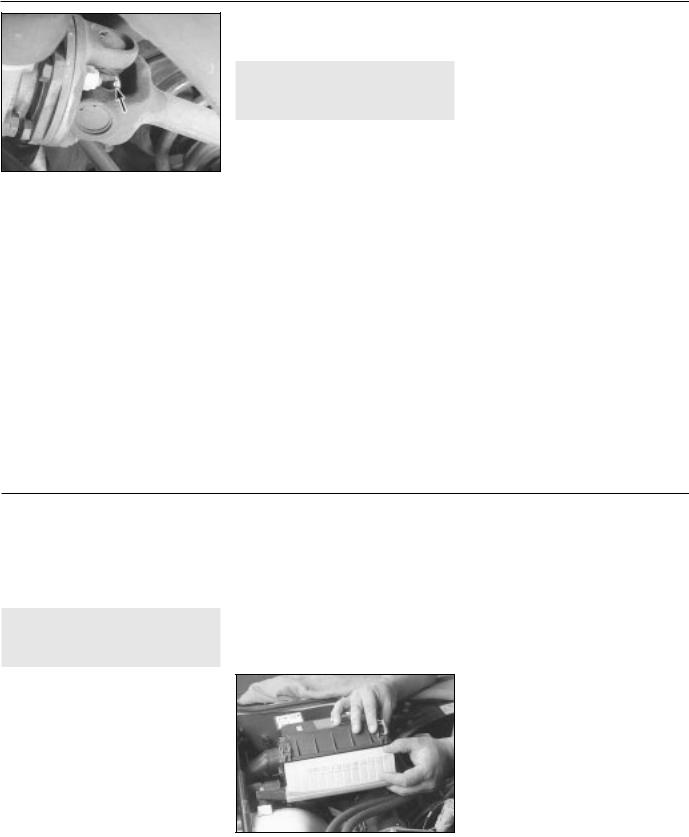
1•14 Every 7500 miles or 6 months
14.6 Grease fittings for the rear driveshafts are located in the centre on each U-joint
8Clean and lubricate the handbrake cable, along with the cable guides and levers. This can be done by smearing some of the chassis grease onto the cable and its related parts with your fingers.
9Open the bonnet and smear a little chassis grease on the bonnet latch mechanism. Have an assistant pull the bonnet release lever from inside the car as you lubricate the cable at the latch.
10Lubricate all the hinges (door, bonnet, etc.) with engine oil to keep them in proper working order.
11The key lock cylinders can be lubricated with spray graphite or silicone lubricant, which is available at motor factors.
12 Lubricate the door weather-stripping with silicone spray. This will reduce chafing and retard wear.
15 Road test |
1 |
|
Instruments and electrical equipment
1Check the operation of all instruments and electrical equipment.
2Make sure that all instruments read correctly, and switch on all electrical equipment in turn, to check that it functions properly.
Steering and suspension
3Check for any abnormalities in the steering, suspension, handling or road “feel”.
4Drive the car, and check that there are no unusual vibrations or noises.
5Check that the steering feels positive, with no excessive “sloppiness”, or roughness, and check for any suspension noises when cornering and driving over bumps.
Drivetrain
6 Check the performance of the engine and transmission, listening for any unusual noises.
7Make sure that the engine runs smoothly when idling, and that there is no hesitation when accelerating.
8Check that the gear changing action of the transmission is smooth and progressive and that the drive is taken up smoothly from a standing start.
Braking system
9Make sure that the car does not pull to one side when braking, and that the wheels do not lock prematurely when braking hard.
10Check that there is no vibration through the steering when braking.
11Check that the handbrake operates correctly without excessive movement of the lever, and that it holds the car stationary on a slope.
12Test the operation of the brake servo unit as follows. With the engine off, depress the footbrake four or five times to exhaust the vacuum. Hold the brake pedal depressed, then start the engine. As the engine starts, there should be a noticeable “give” in the brake pedal as vacuum builds up. Allow the engine to run for at least two minutes, and then switch it off. If the brake pedal is depressed now, it should be possible to detect a hiss from the servo as the pedal is depressed. After about four or five depressions, no further hissing should be heard, and the pedal should feel considerably harder.
Every 15 000 miles (24 000 km) or 12 months
16 Spark plug renewal |
2 |
|
|
|
|
Refer to Section 4, renewing the plugs regardless of their apparent condition.
17 Air cleaner element renewal 1
1The air filter is located inside a housing at the left side of the engine compartment. To remove the air filter, release the four spring clips that secure the two halves of the air cleaner housing together, then lift the cover up and remove the air filter element (see illustration).
Caution: Never drive the car with the air cleaner removed. Excessive engine wear could result and backfiring could even cause a fire under the bonnet.
2Wipe out the inside of the air cleaner housing.
3Place the new filter into the air cleaner housing, making sure it seats properly.
4Refitting the cover is the reverse of removal.
18 Fuel filter renewal |
2 |
|
|
|
|
Warning: Petrol is extremely flammable, so take extra precautions when you work on any part of the fuel system.
Don’t smoke or allow open flames or bare light bulbs near the work area, and don’t work in a garage where a natural gas-type
17.1 Detach the clips and separate the cover, then slide the filter element out of the housing
appliance (such as a water heater or clothes dryer) with a pilot light is present. Since petrol is carcinogenic, wear latex gloves when there’s a possibility of being exposed to fuel, and, if you spill any fuel on your skin, rinse it off immediately with soap and water. Mop up any spills immediately and do not store fuel-soaked rags where they could ignite. The fuel system is under constant pressure, so, if any fuel lines are to be disconnected, the fuel pressure in the system must be relieved first (see Chapter 4 for more information). When you perform any kind of work on the fuel system, wear safety glasses and have a Class B type fire extinguisher on hand.
1 The canister type filter is mounted underneath the car on the passenger’s side frame rail just in front of the left rear tyre.
2 Depressurise the fuel system (refer to Chapter 4), then disconnect the cable from the negative terminal of the battery.
3On 1988 to 1990 models, detach the banjo bolt from the outlet side of the filter then remove the union from the inlet side of the filter. Unscrew the filter mounting bolt and remove the filter (see illustration).
4On 1991 to 1994 models, the fuel filter has quick-disconnect fittings that do not require
3261 Jaguar XJ6
